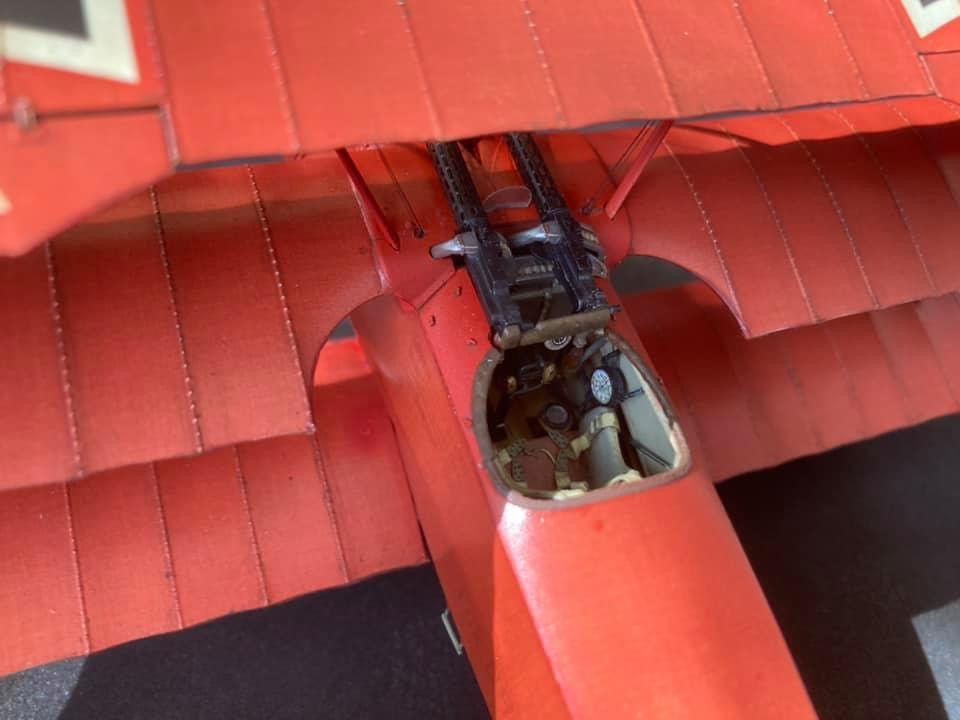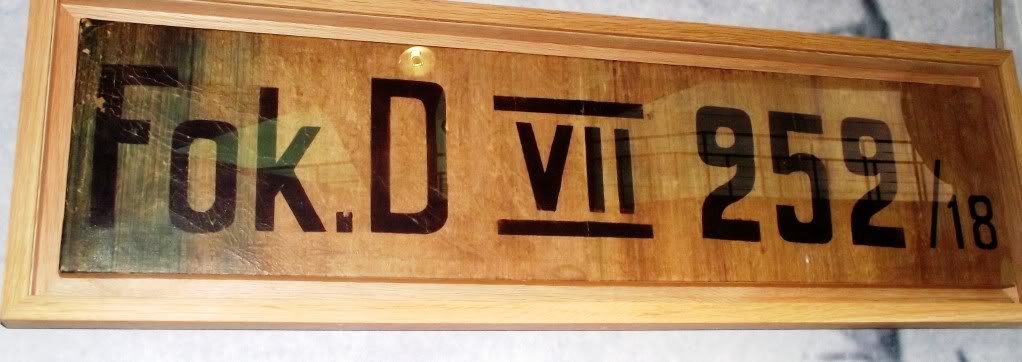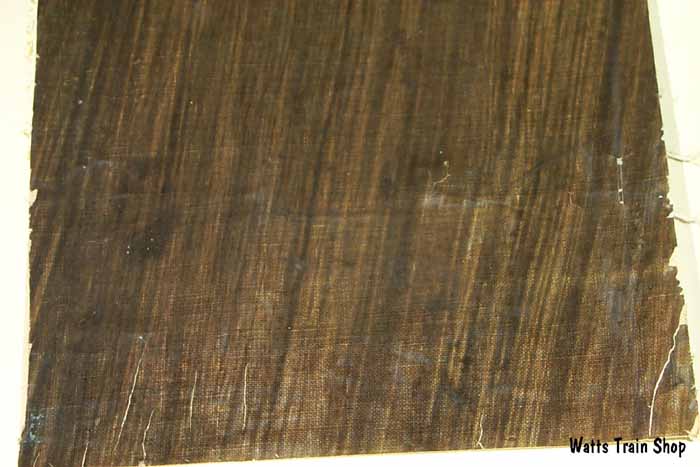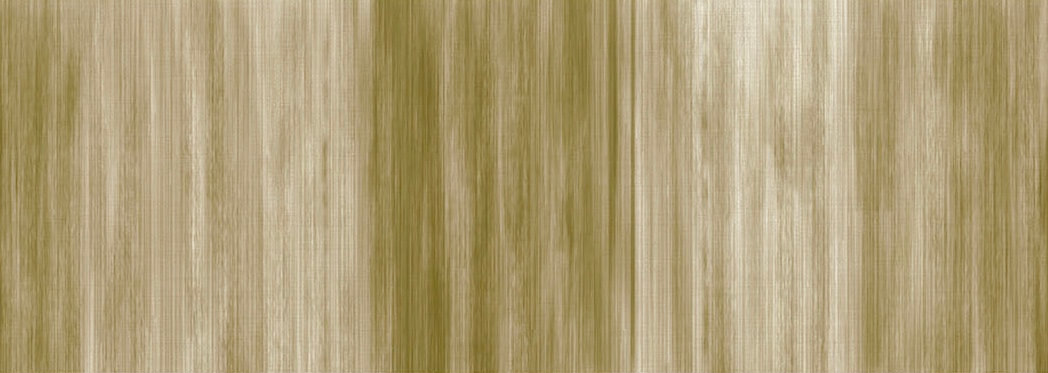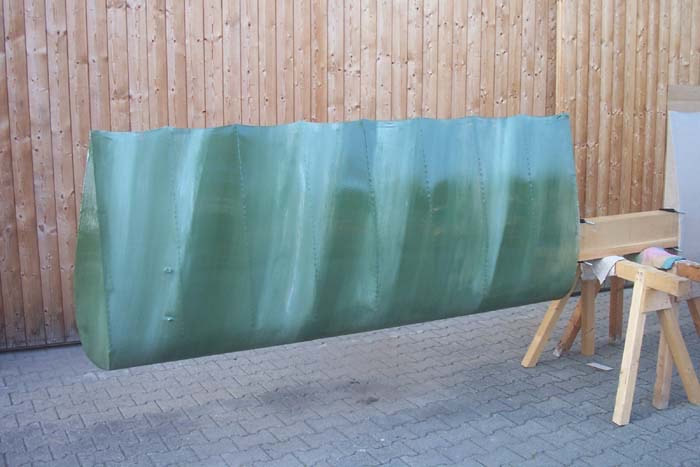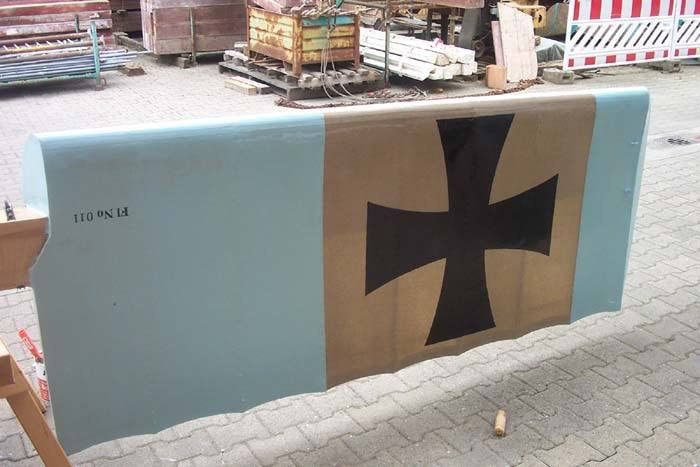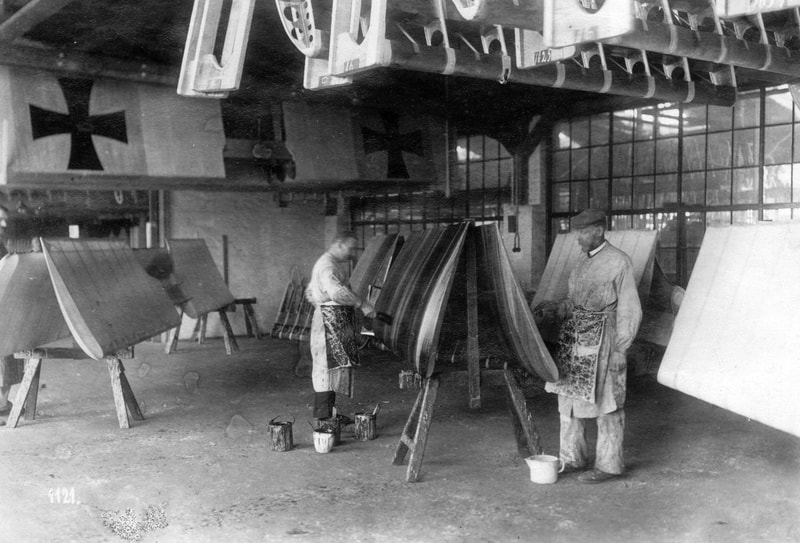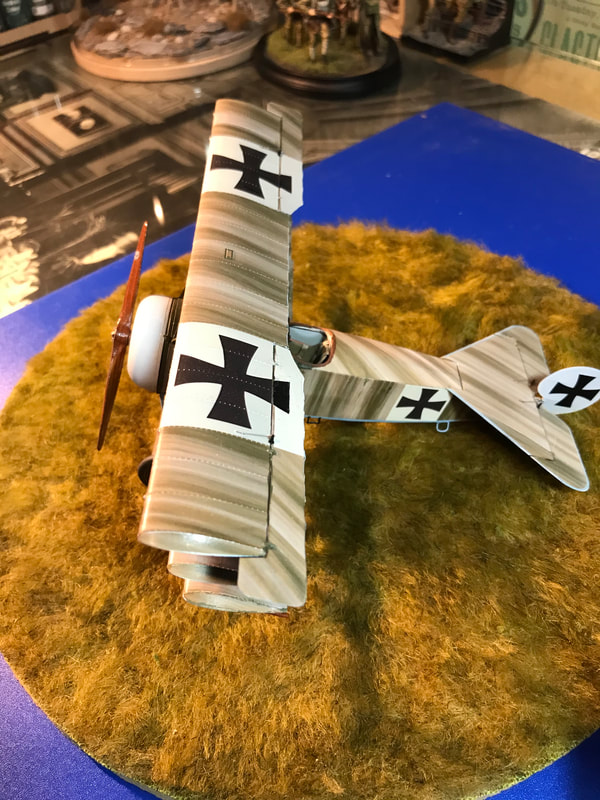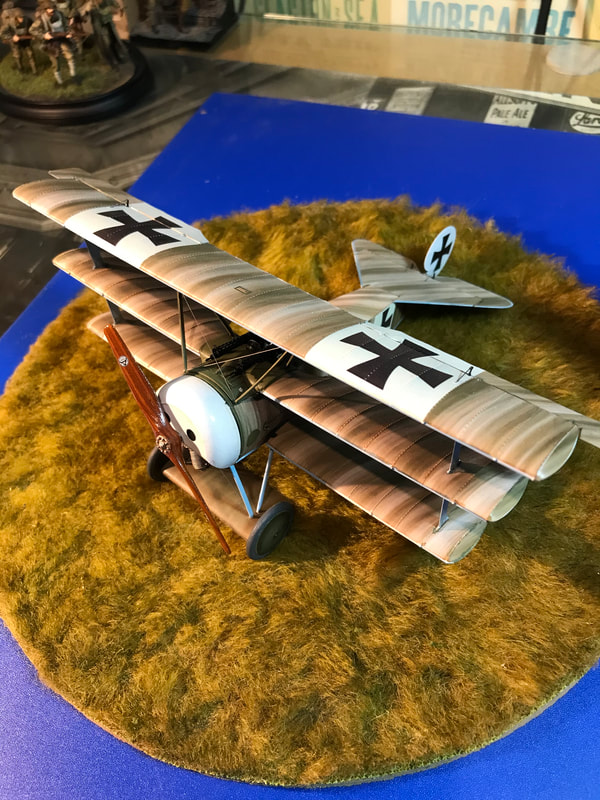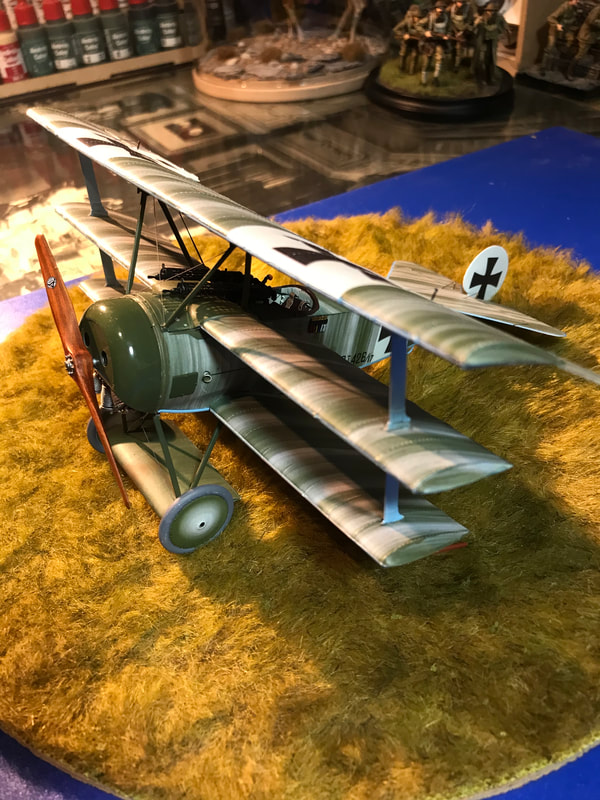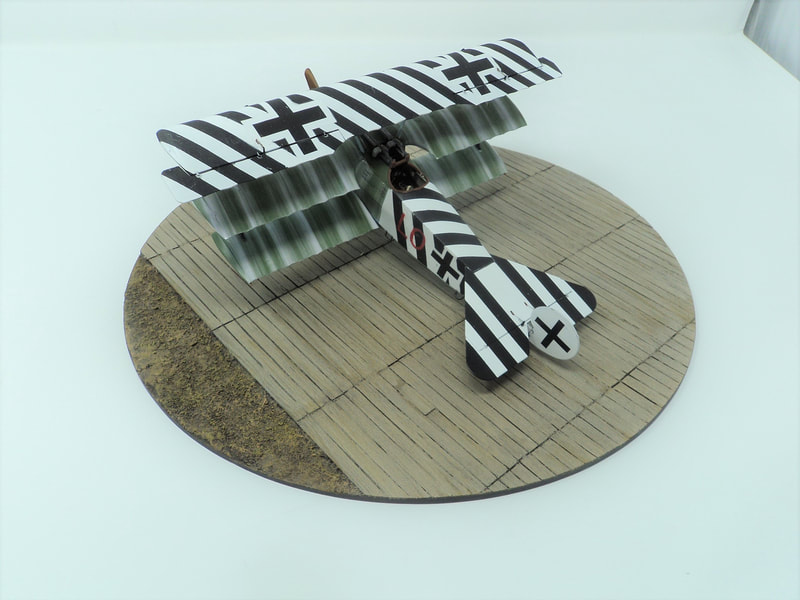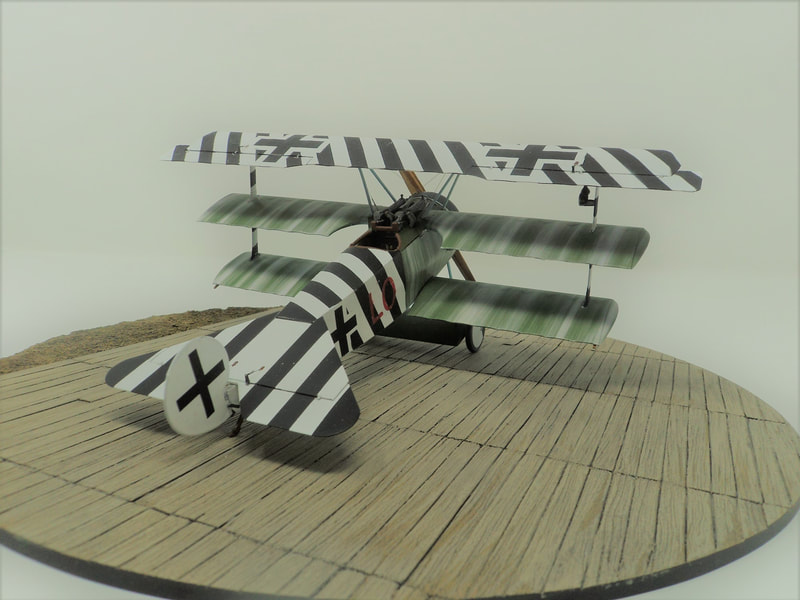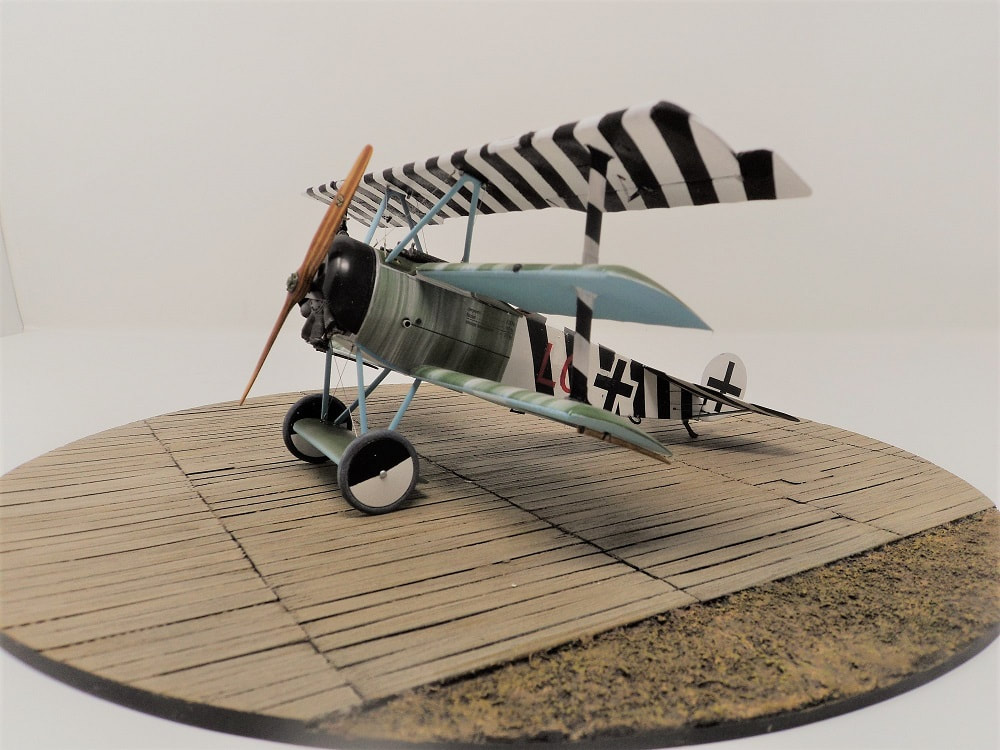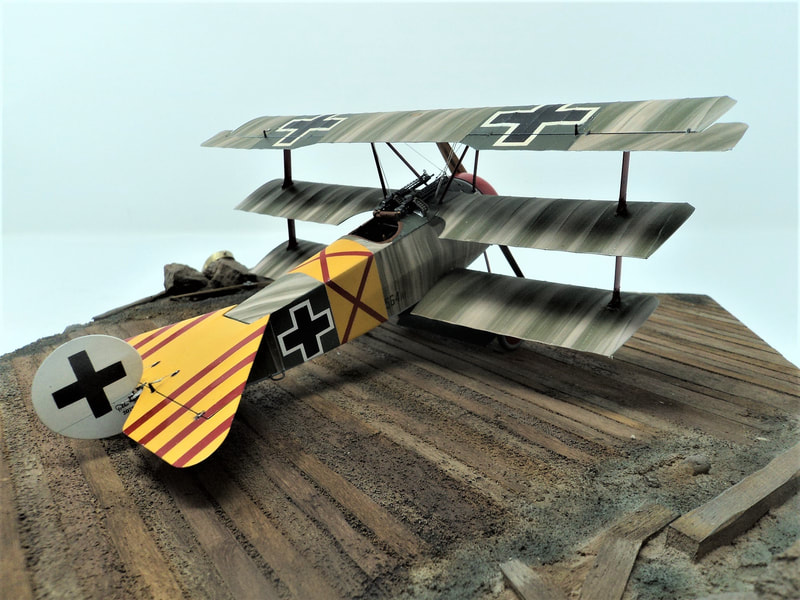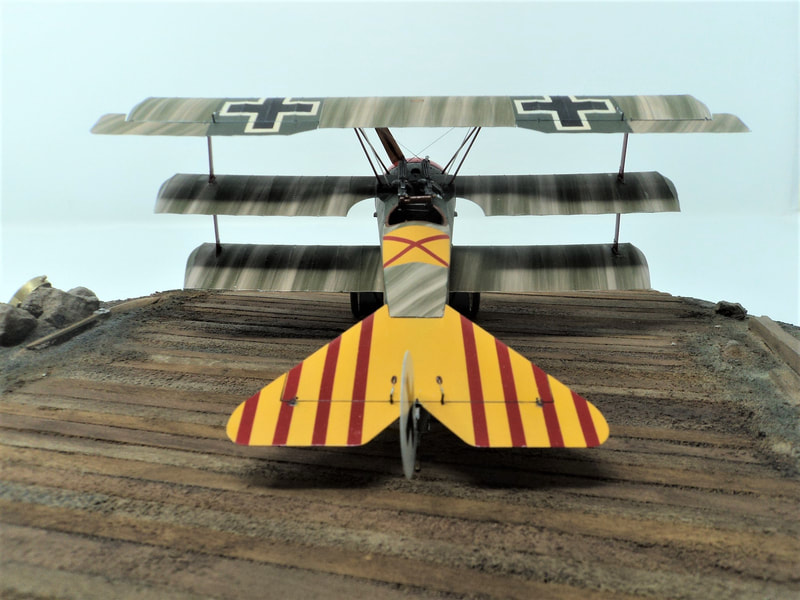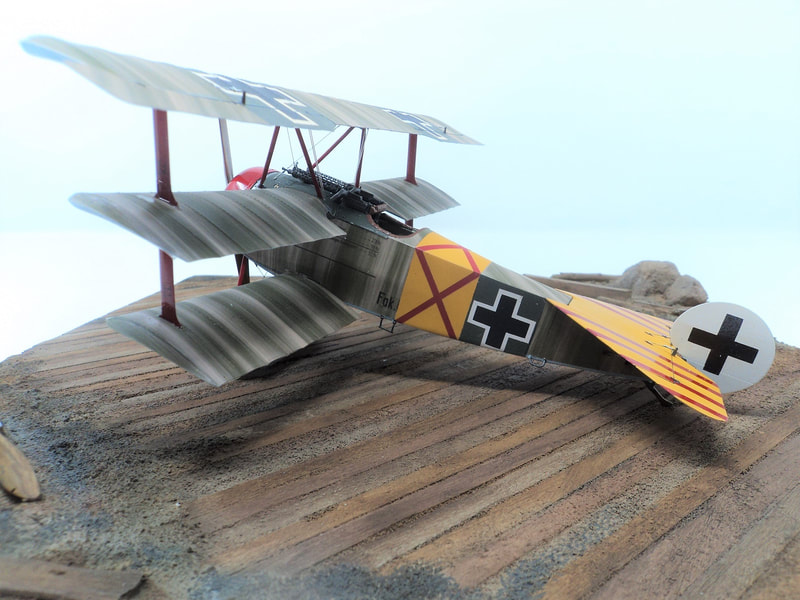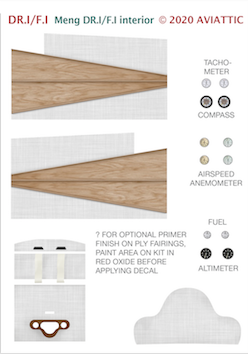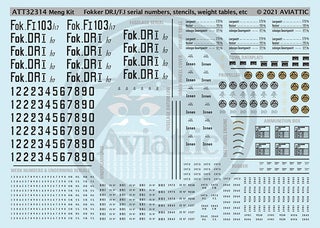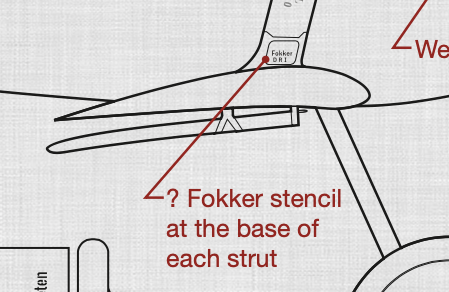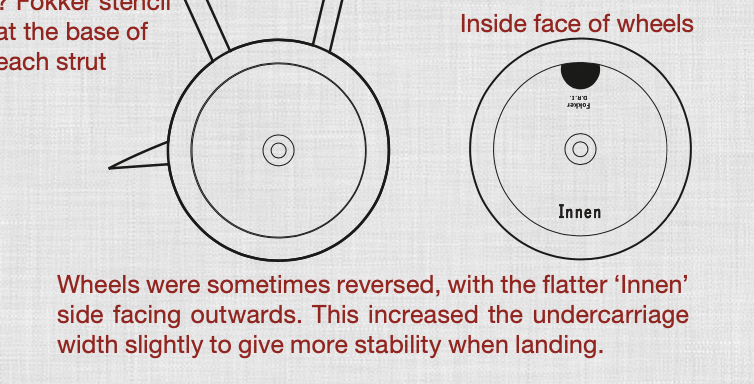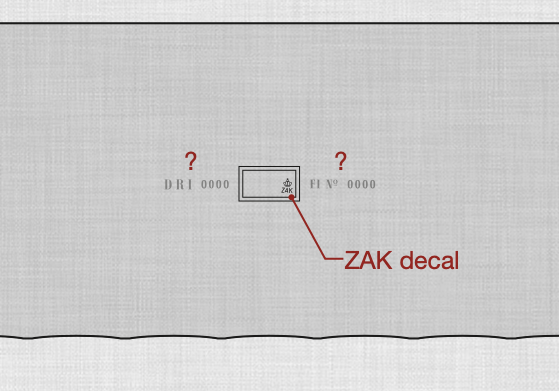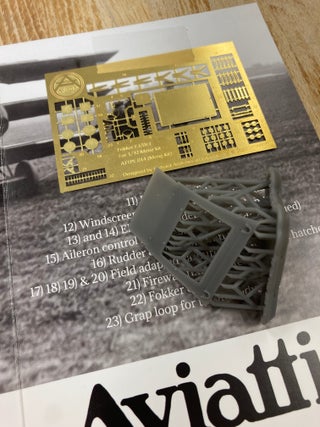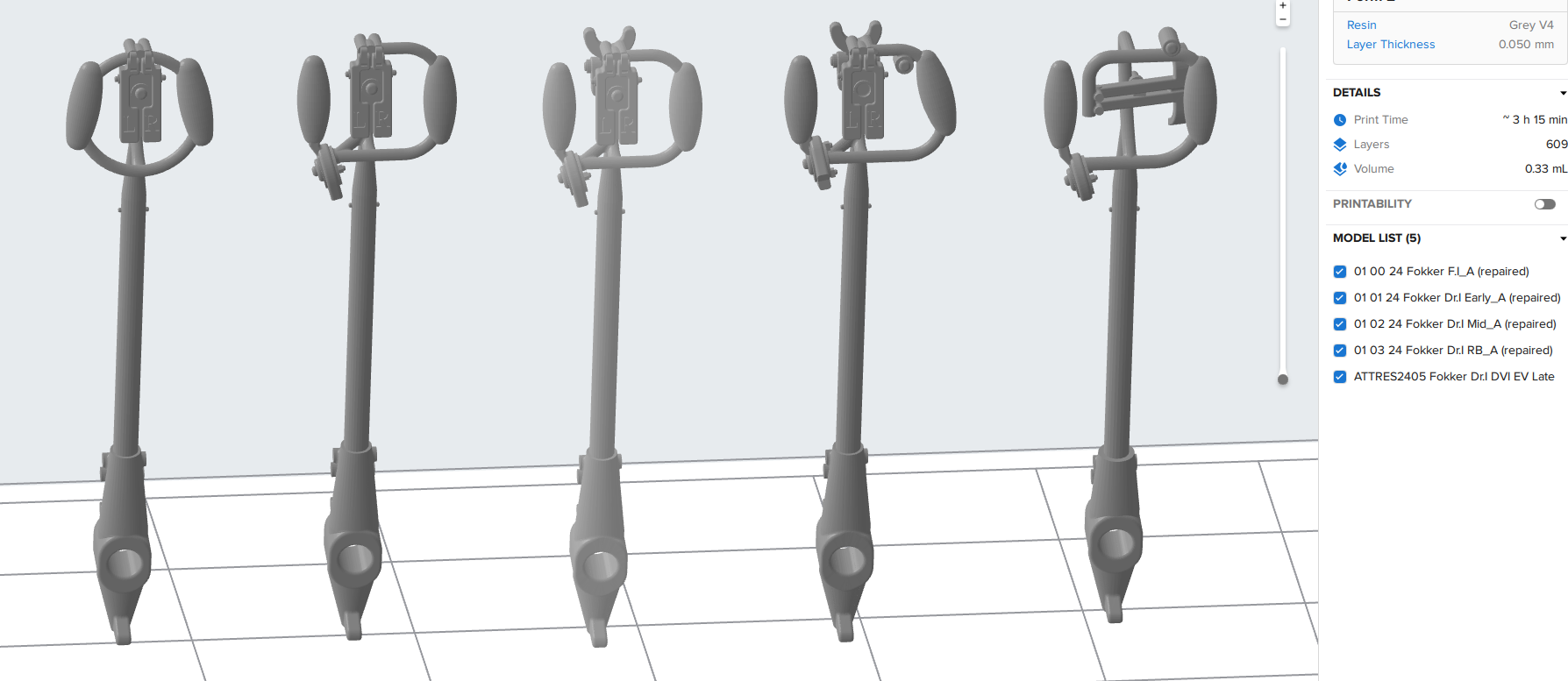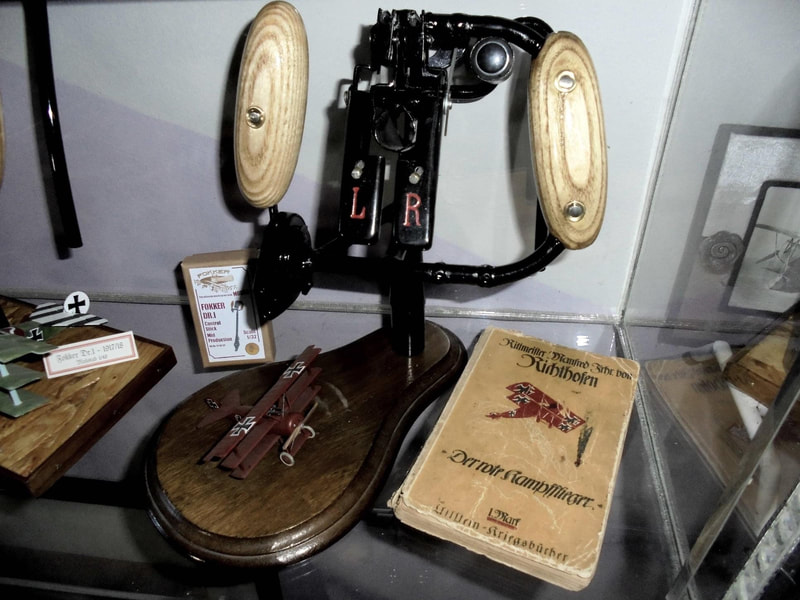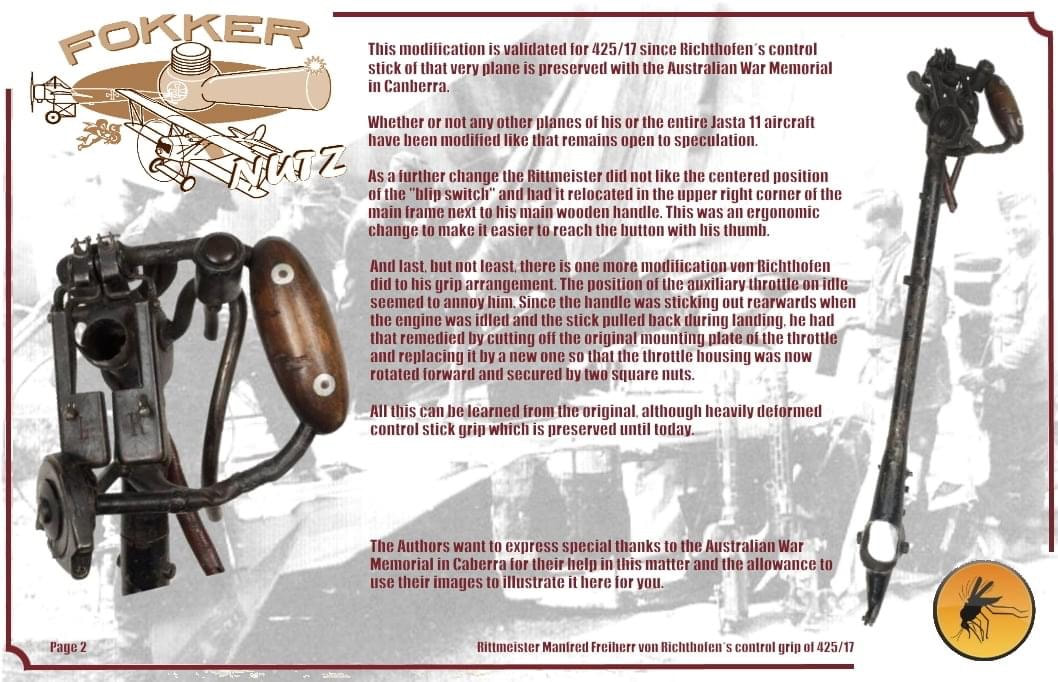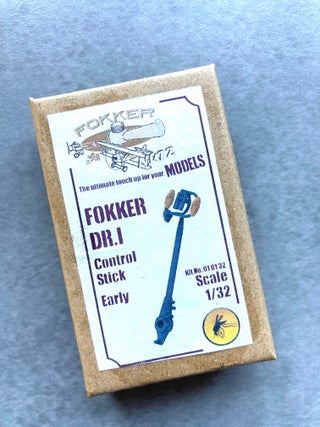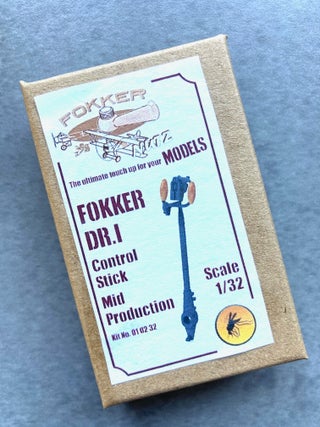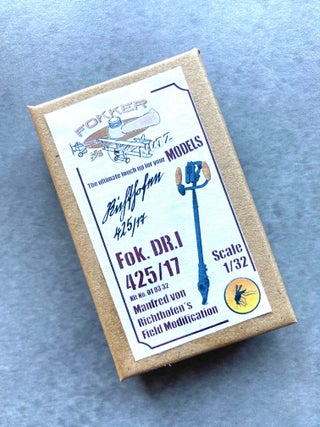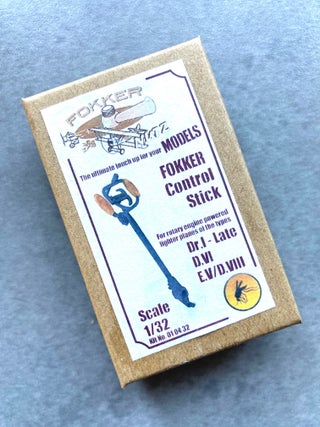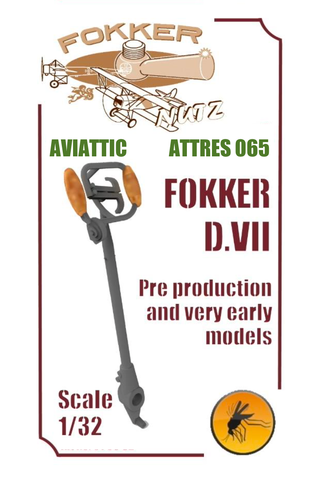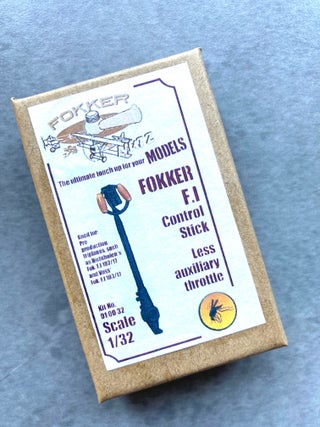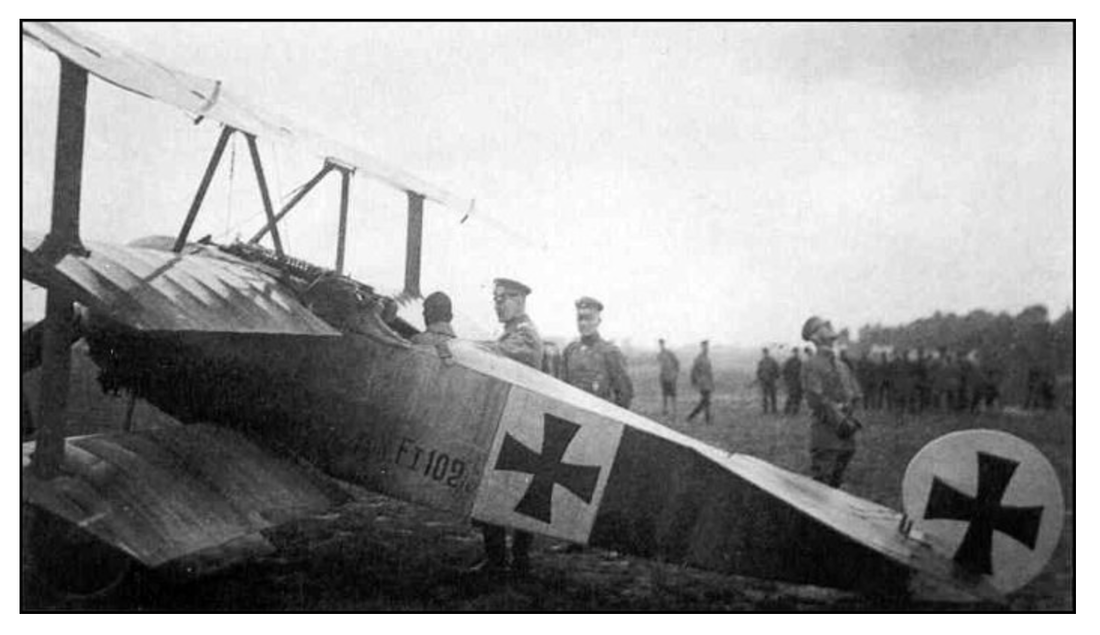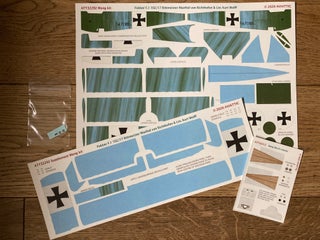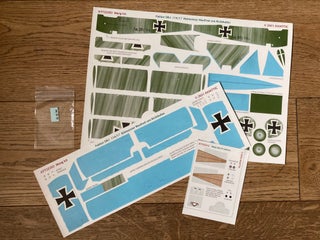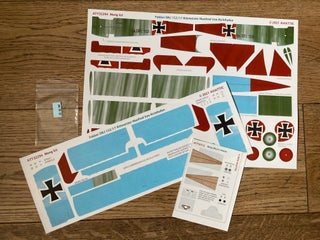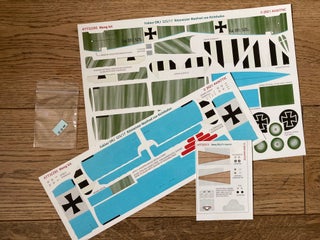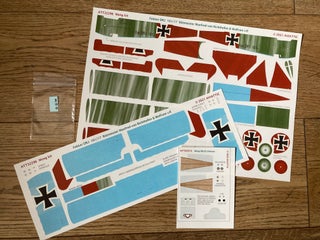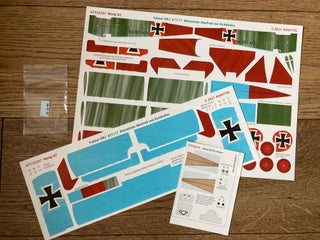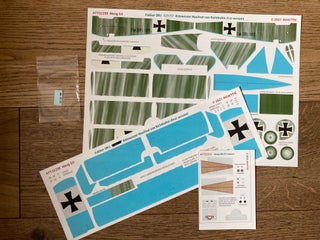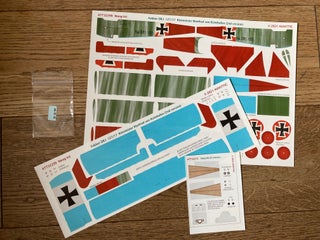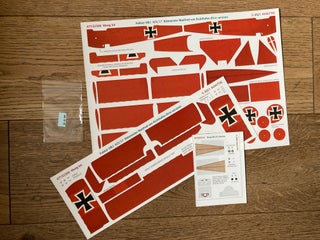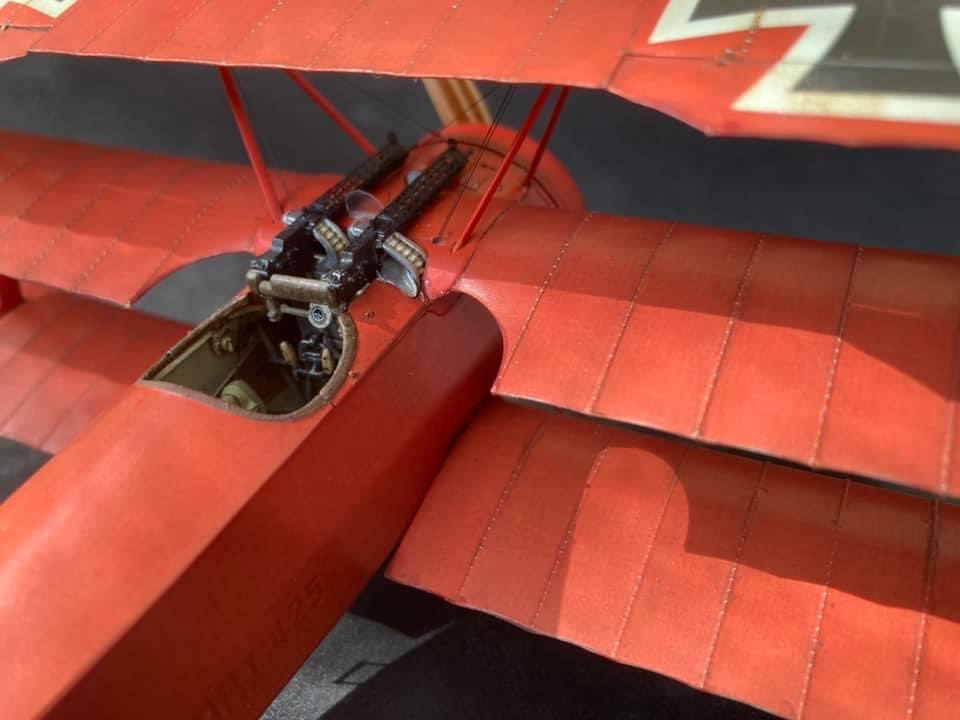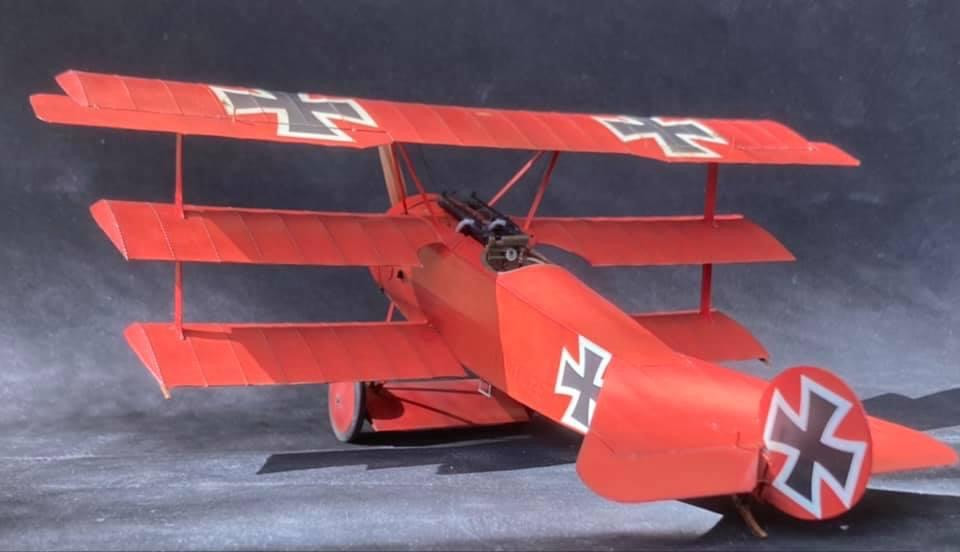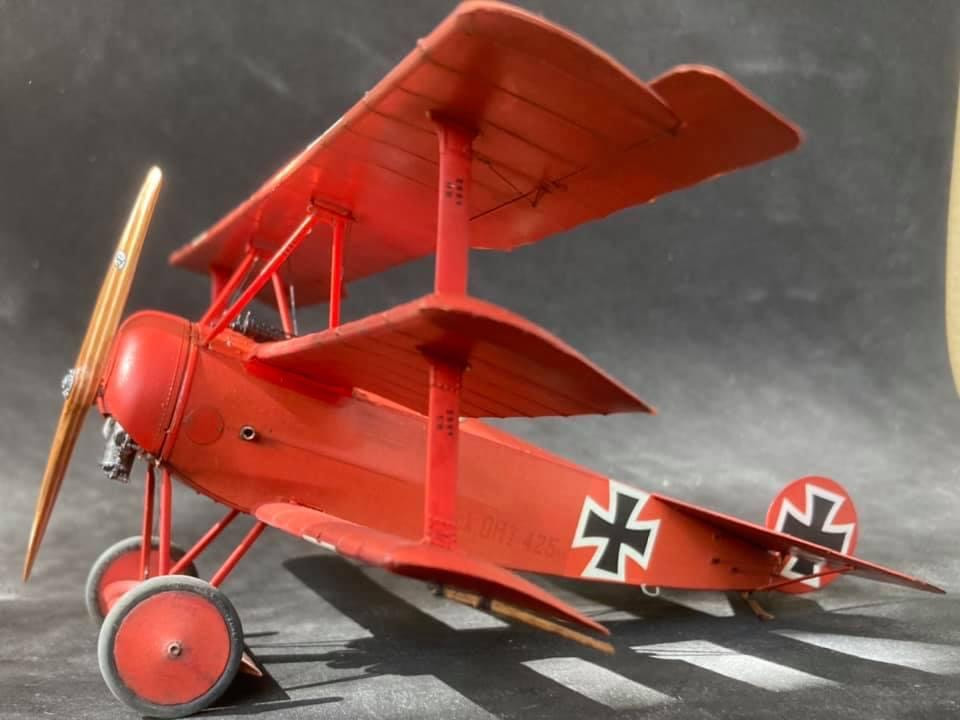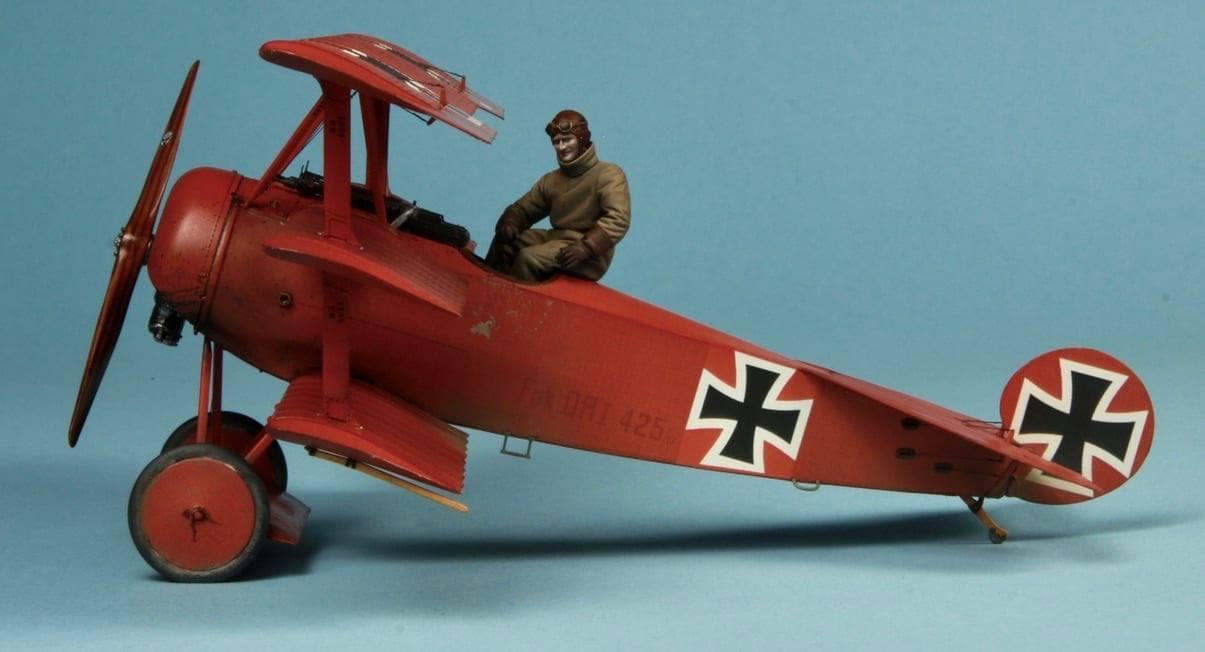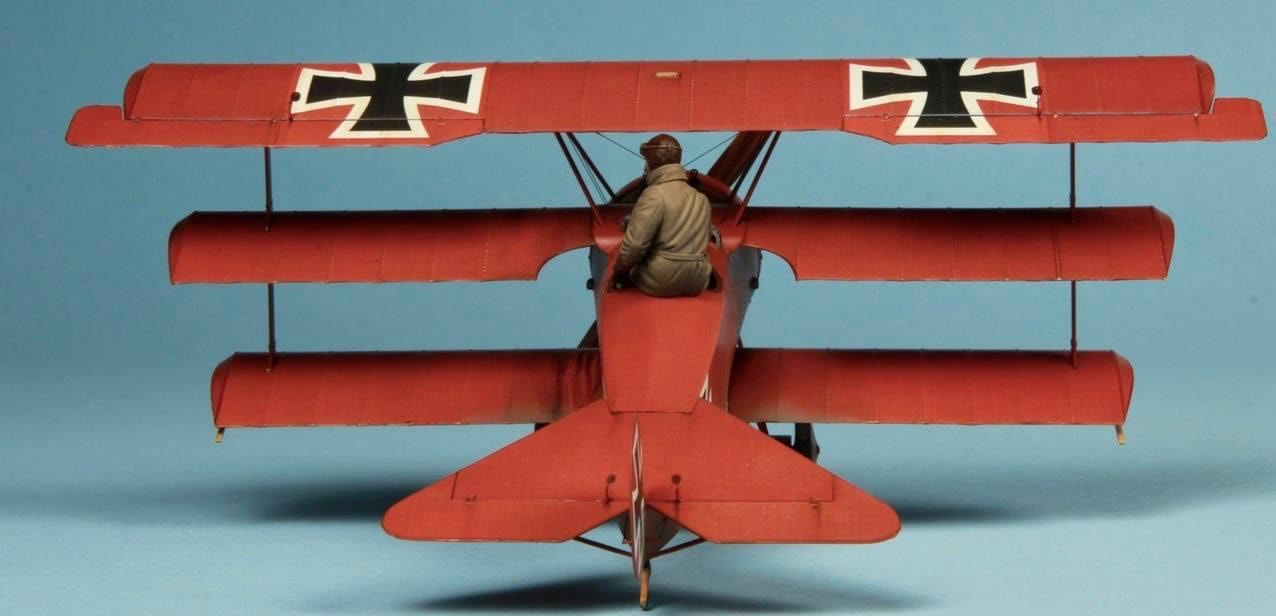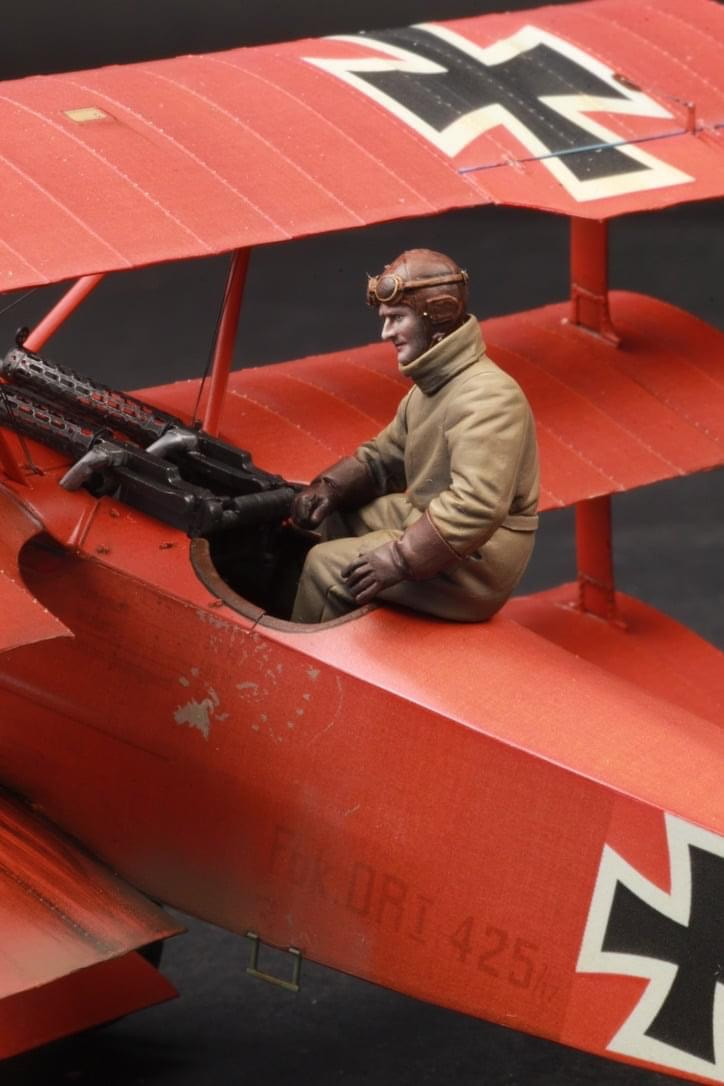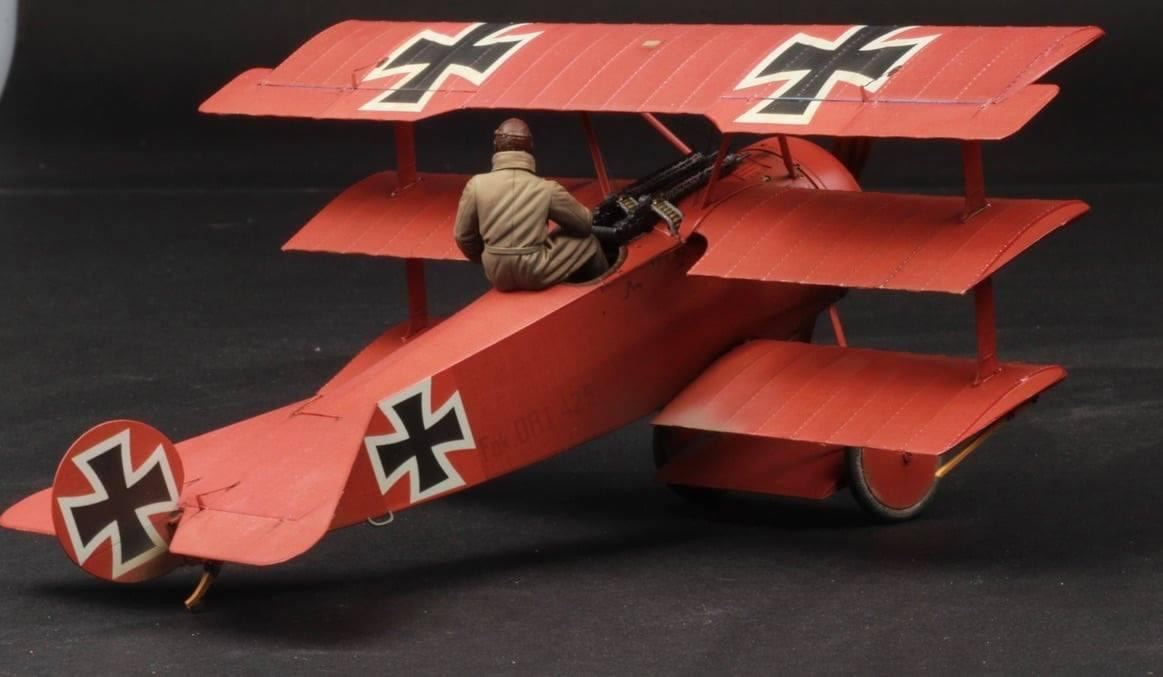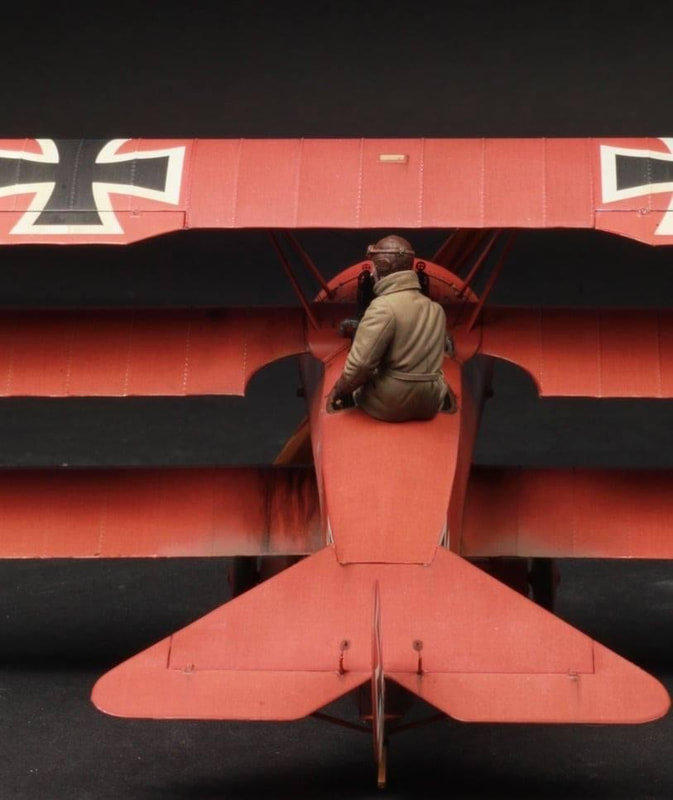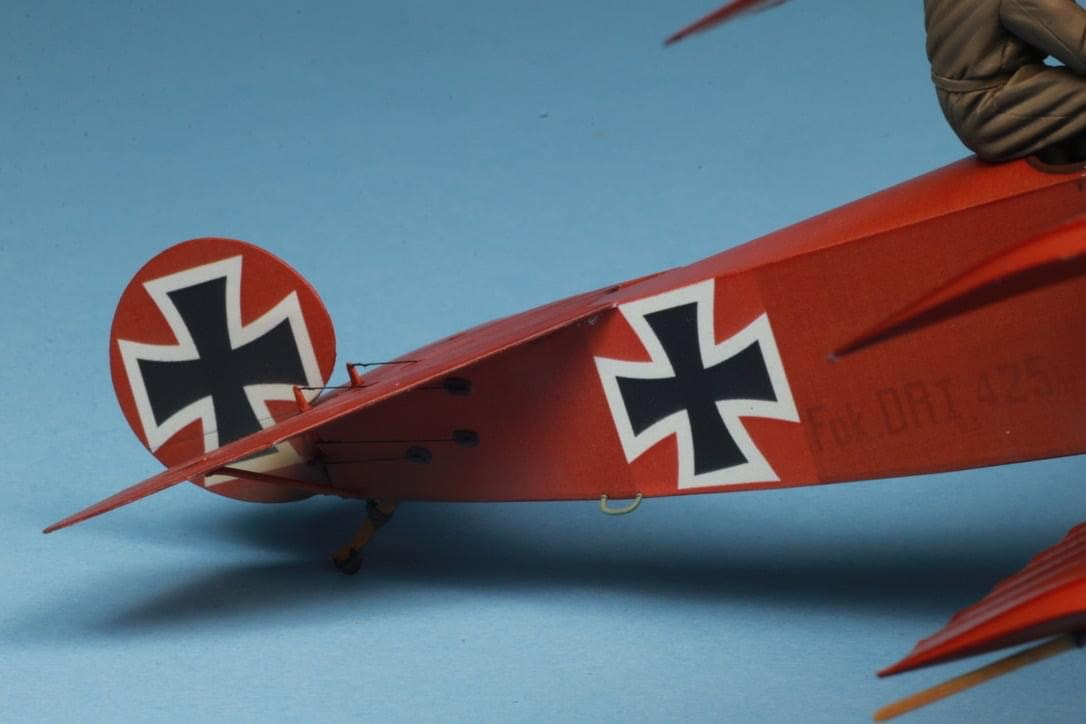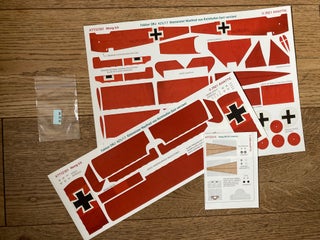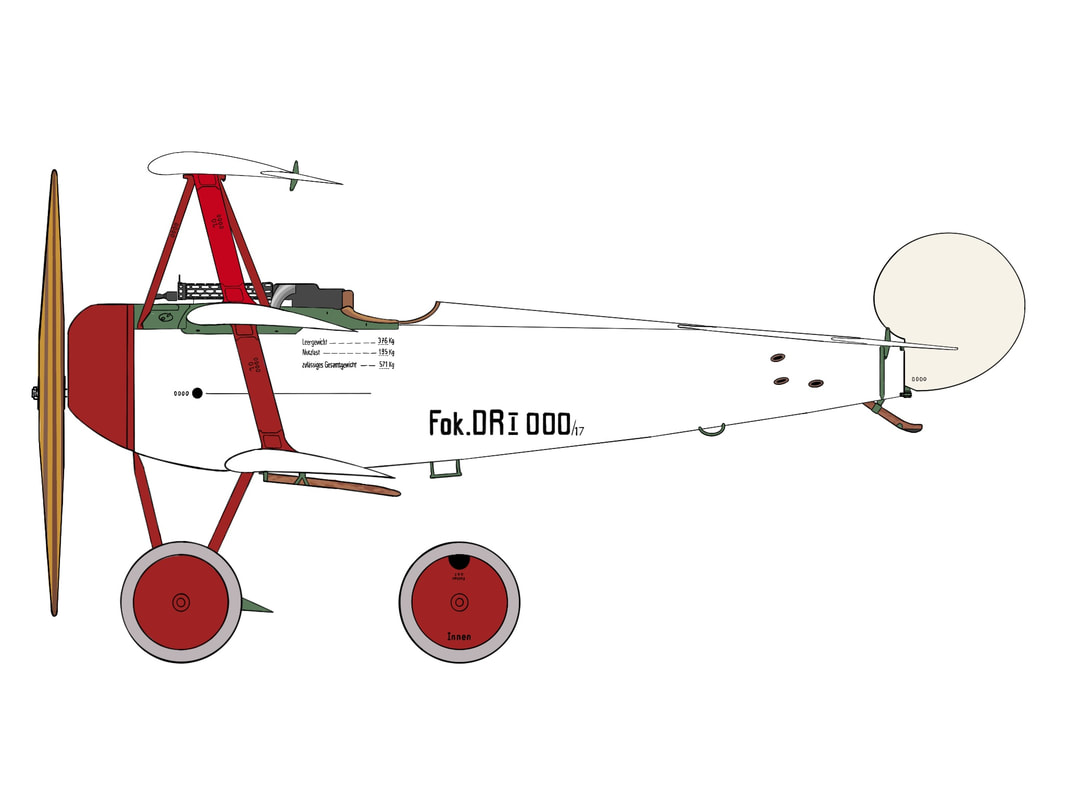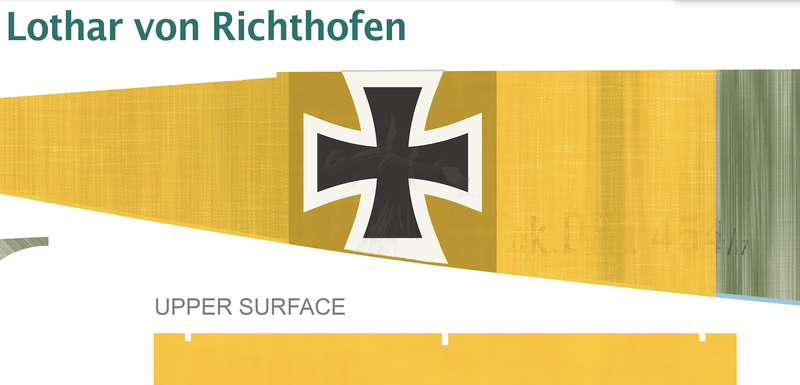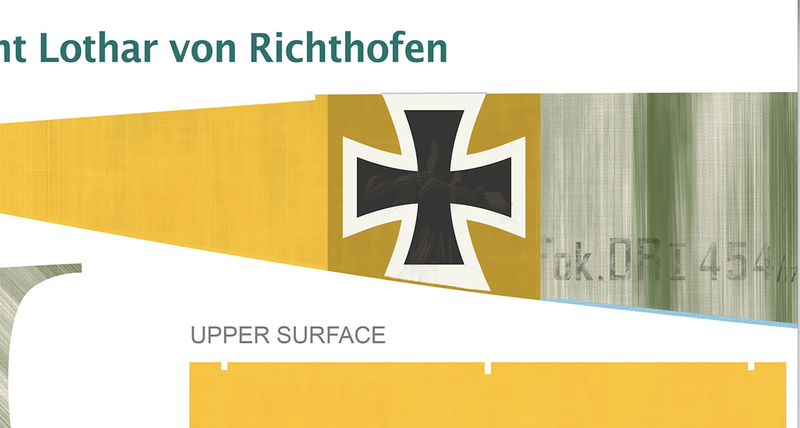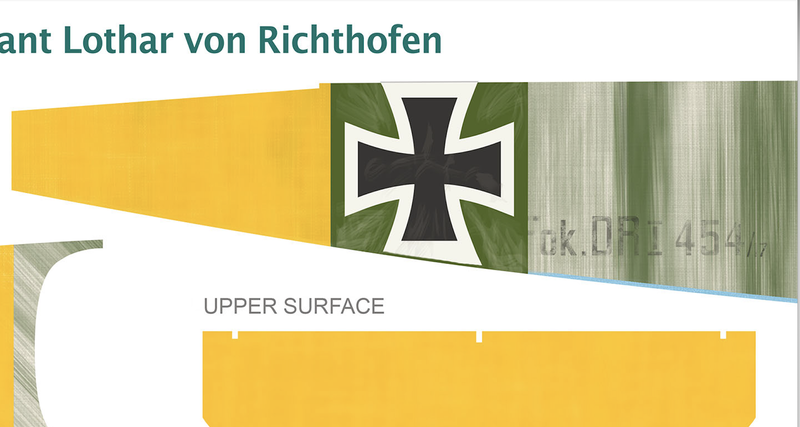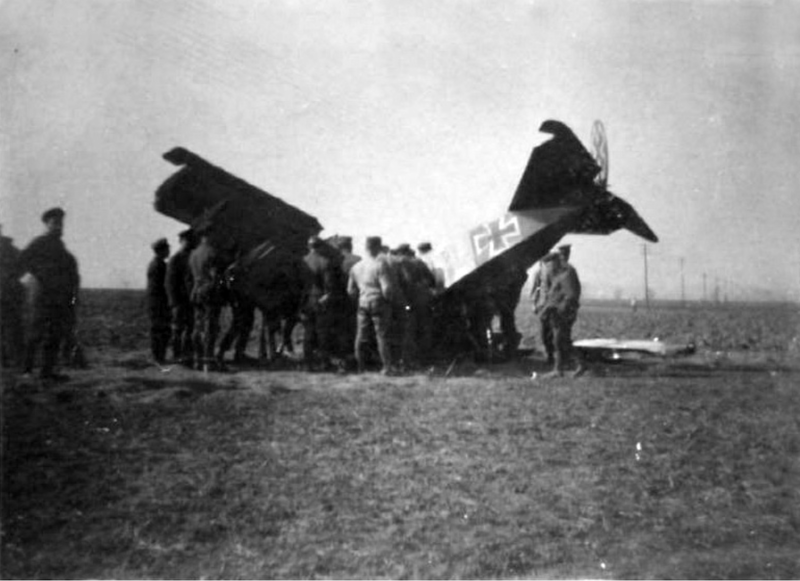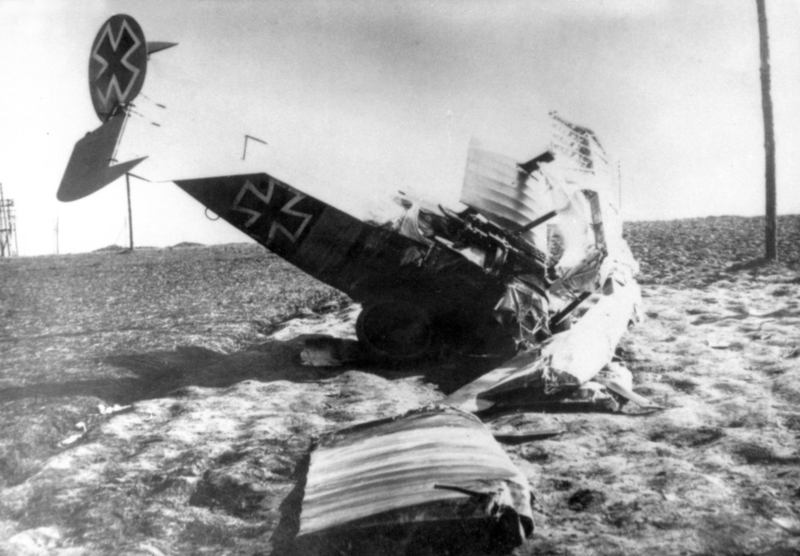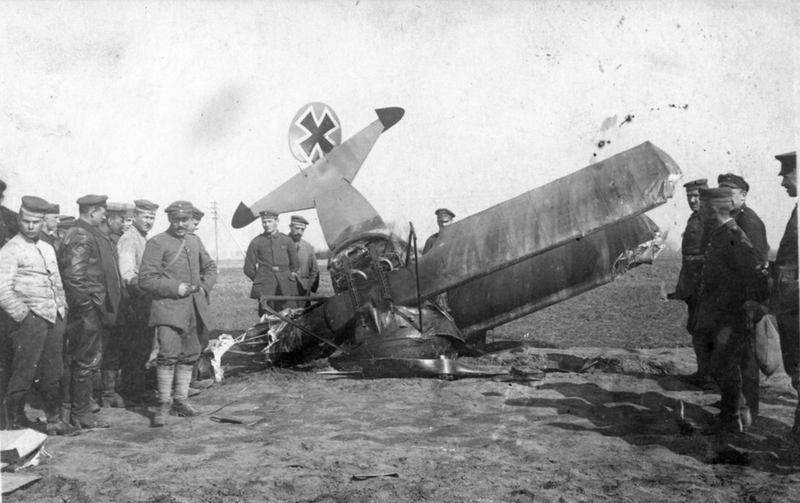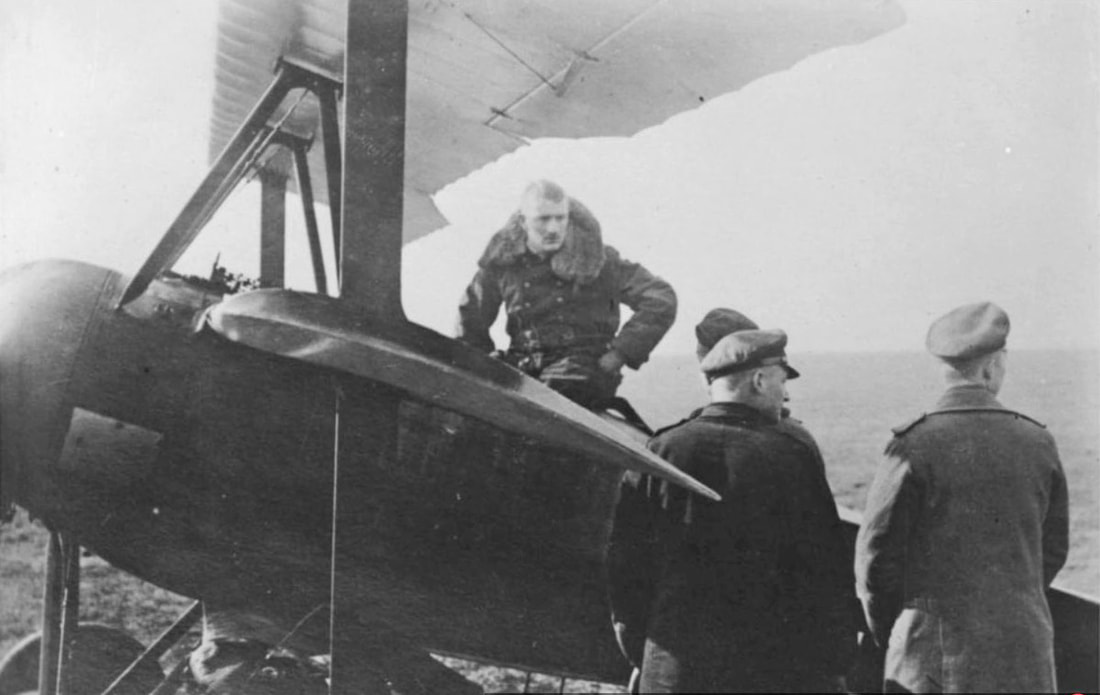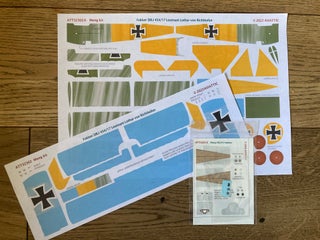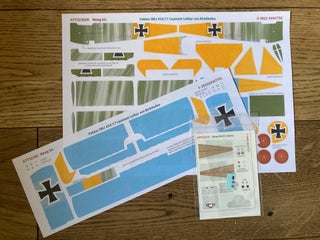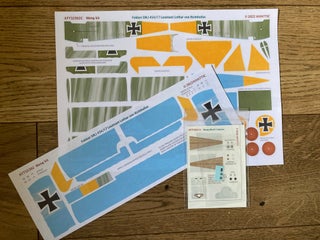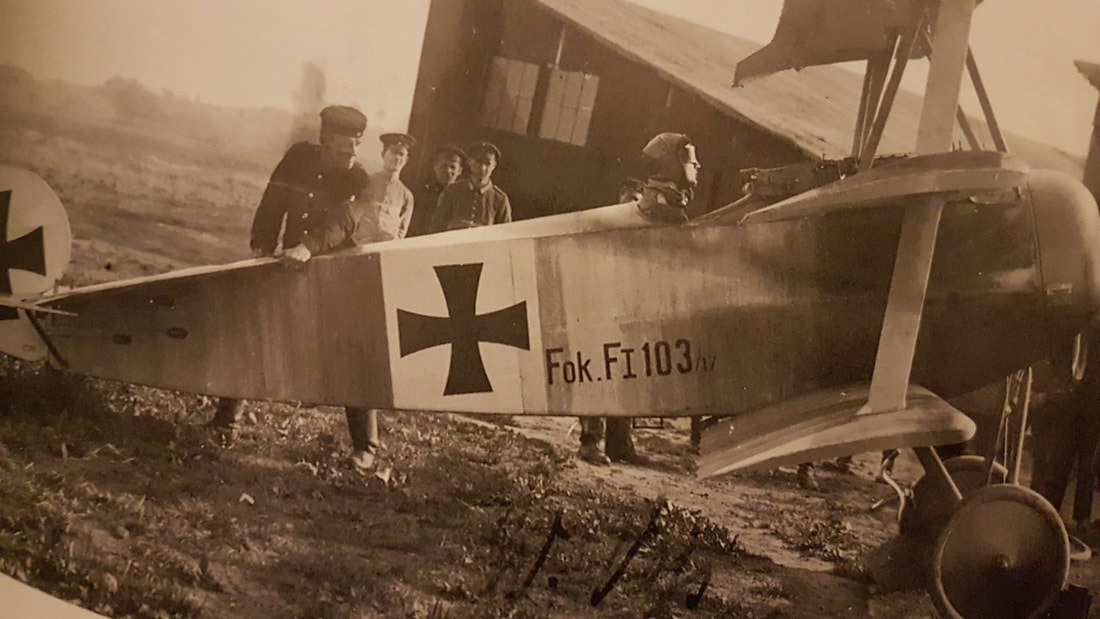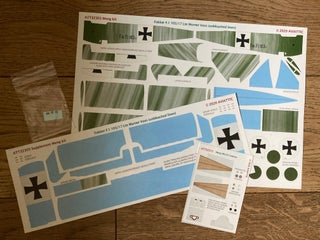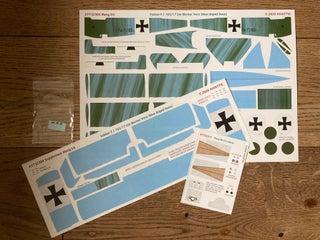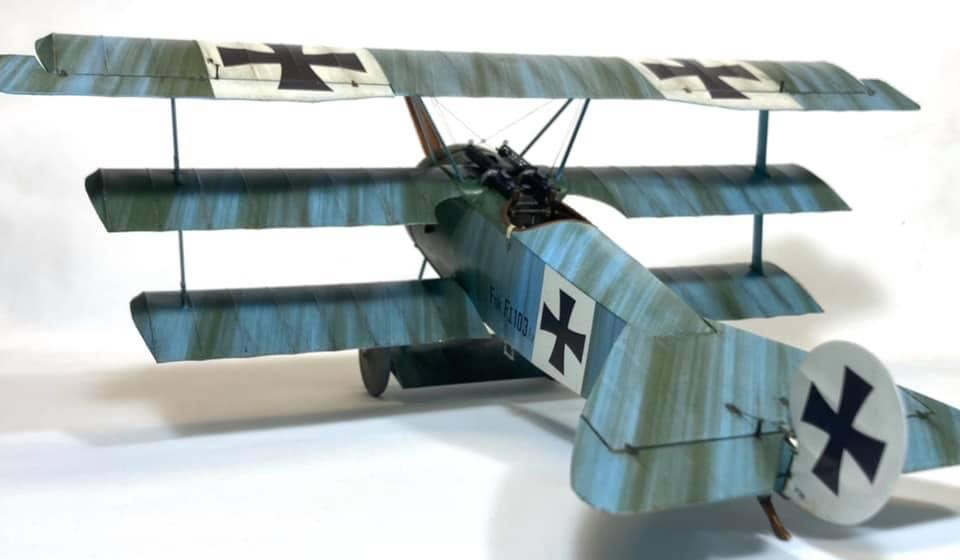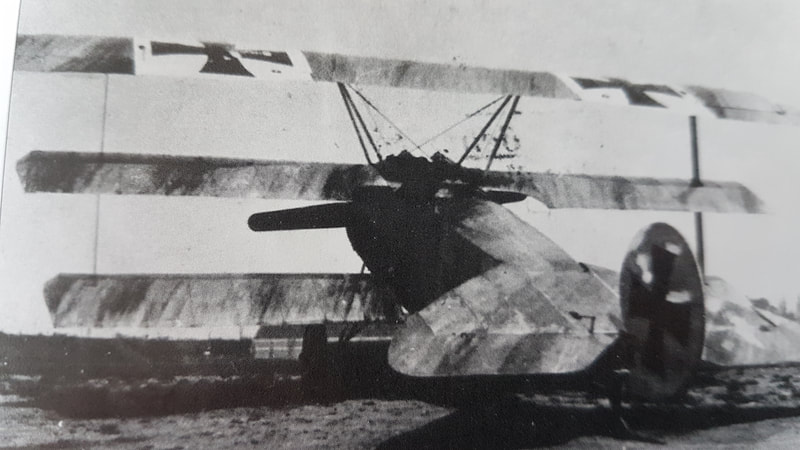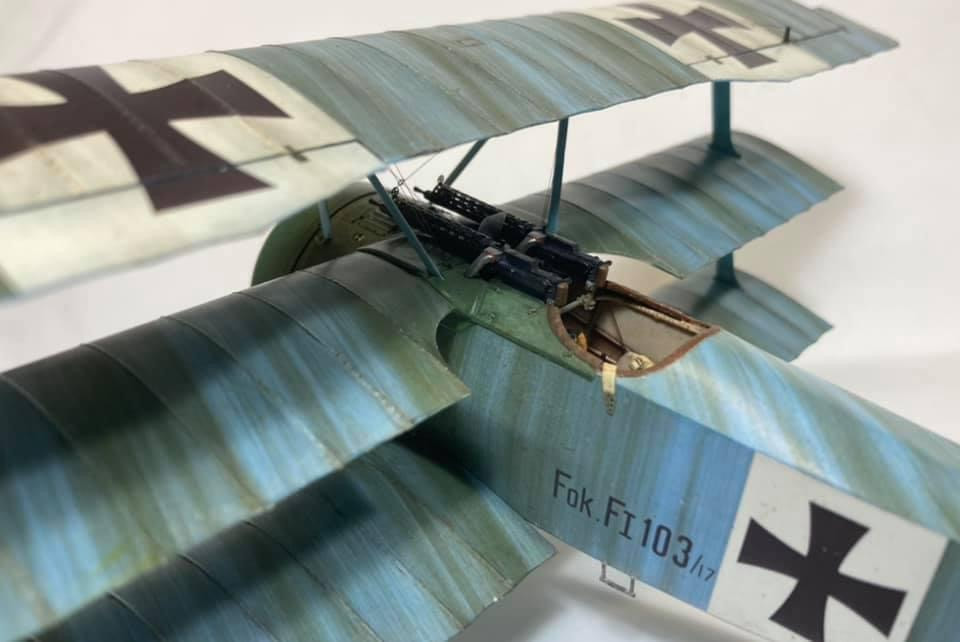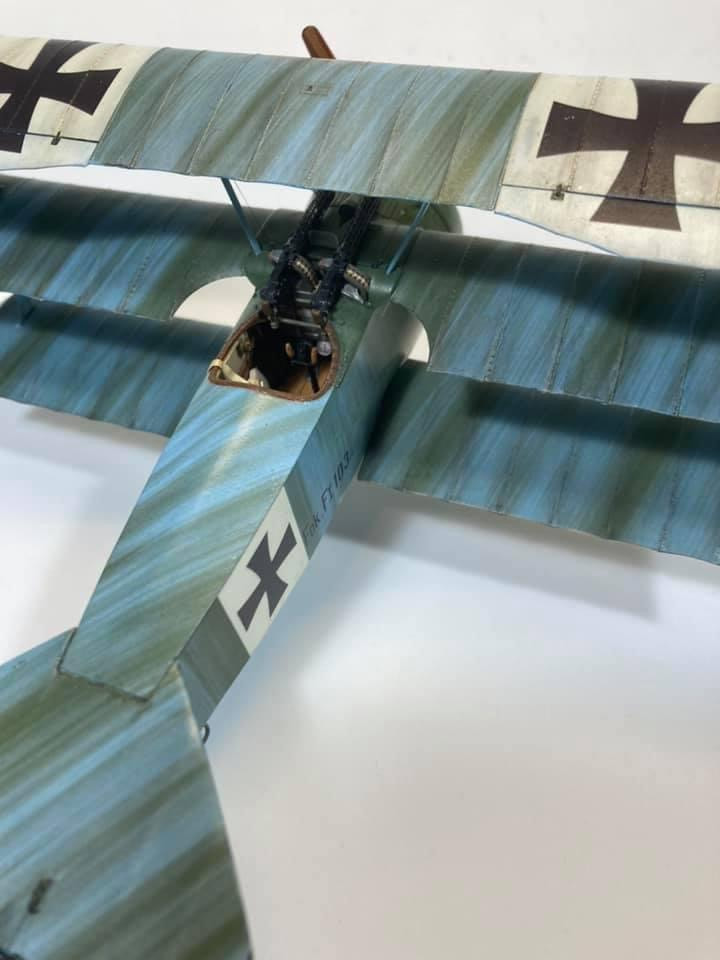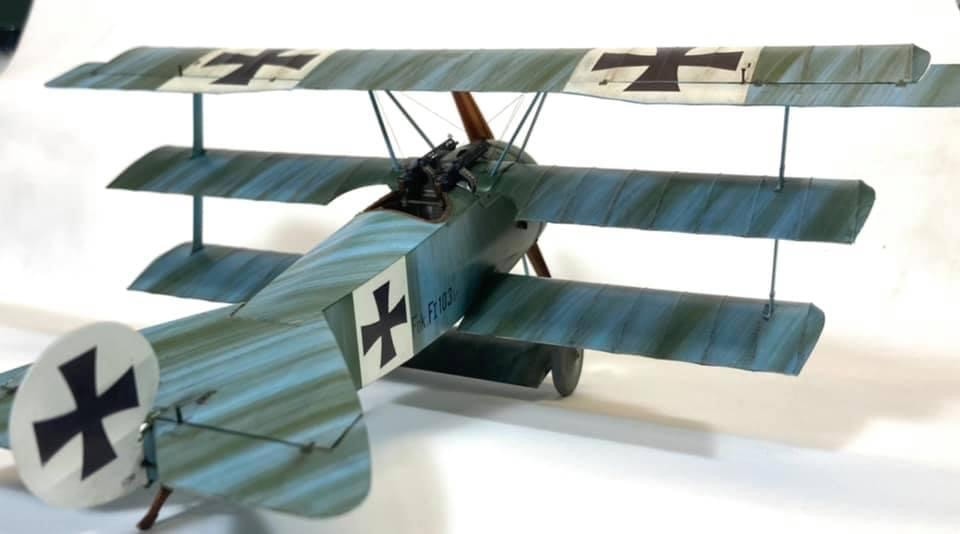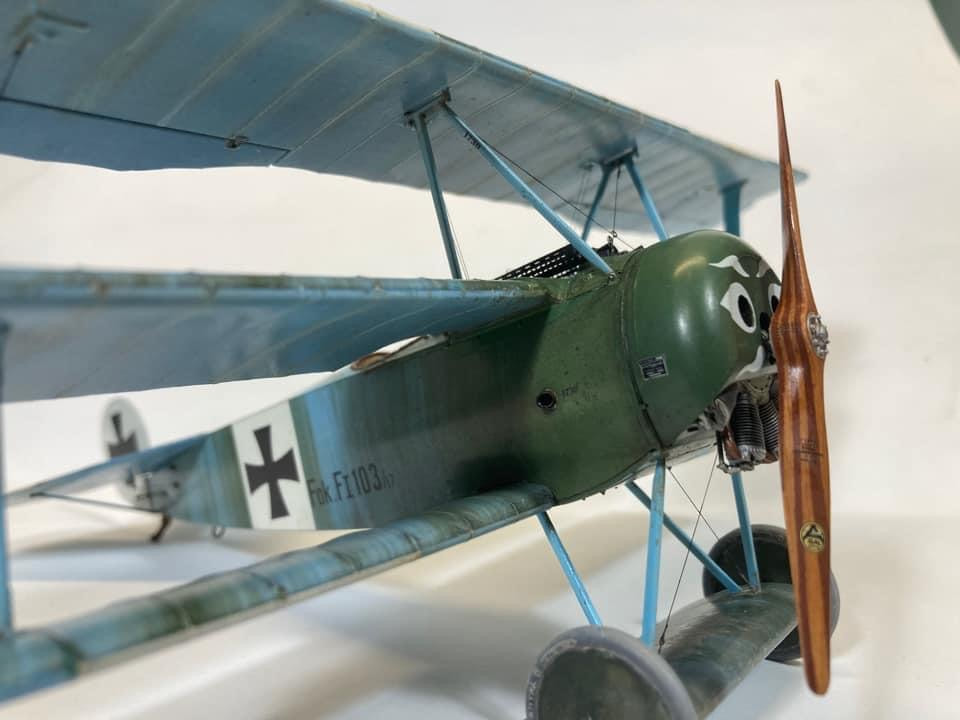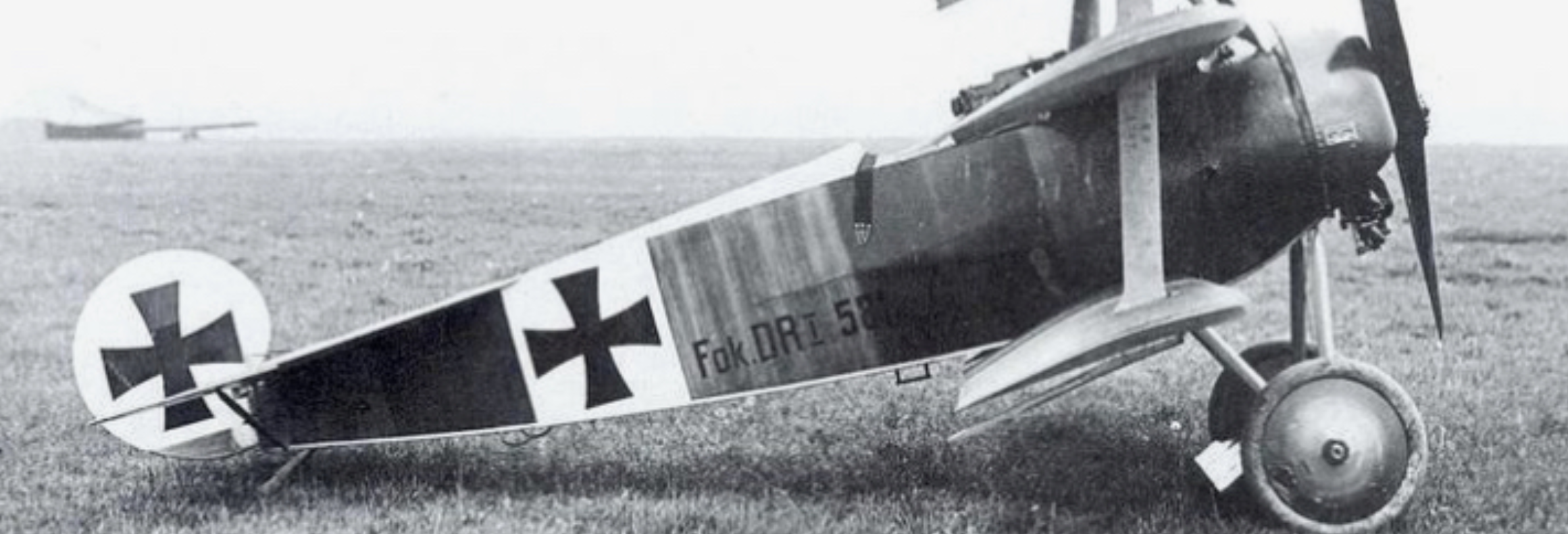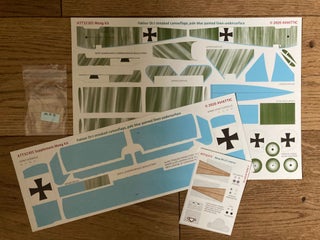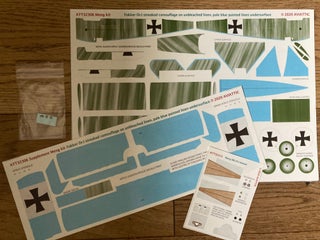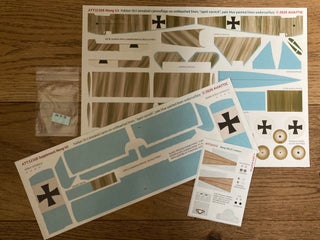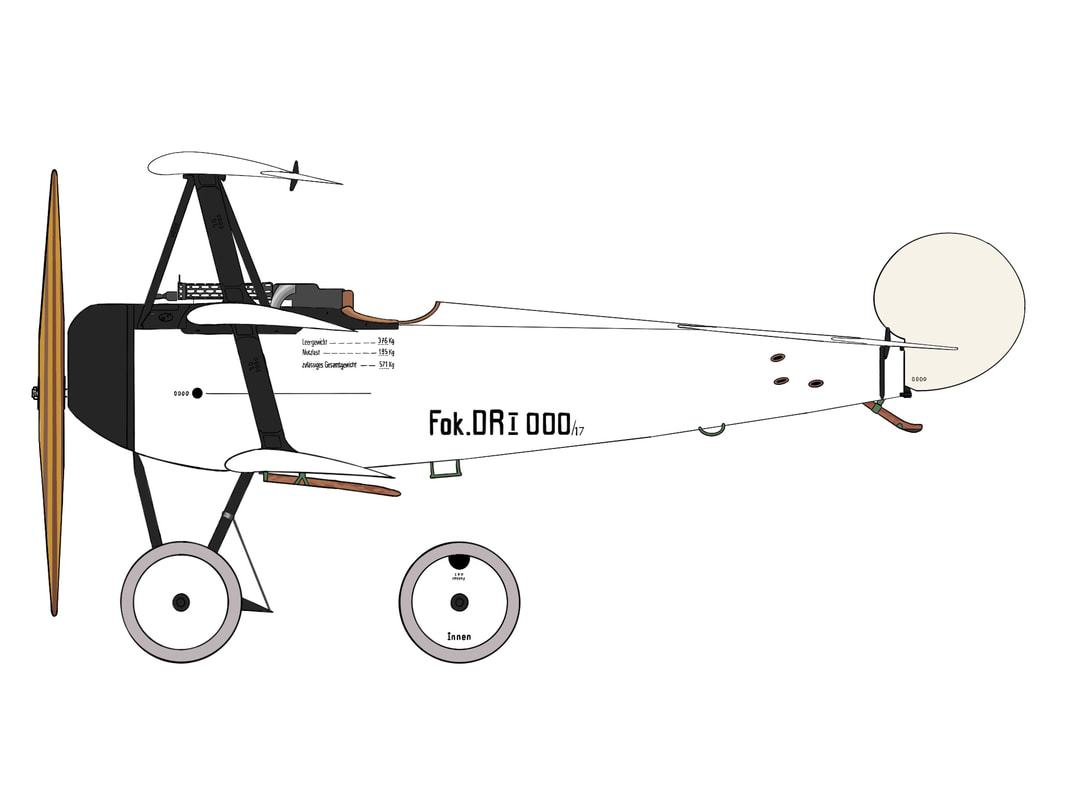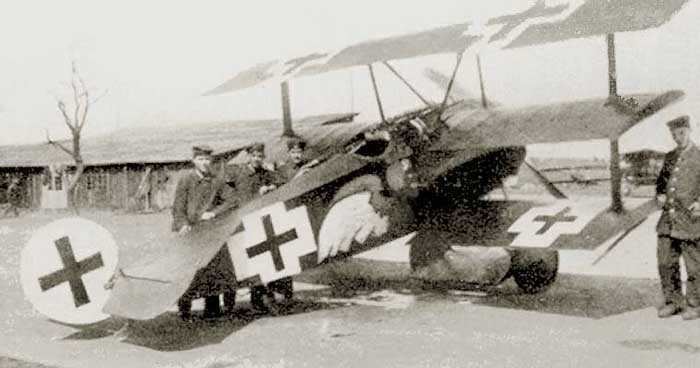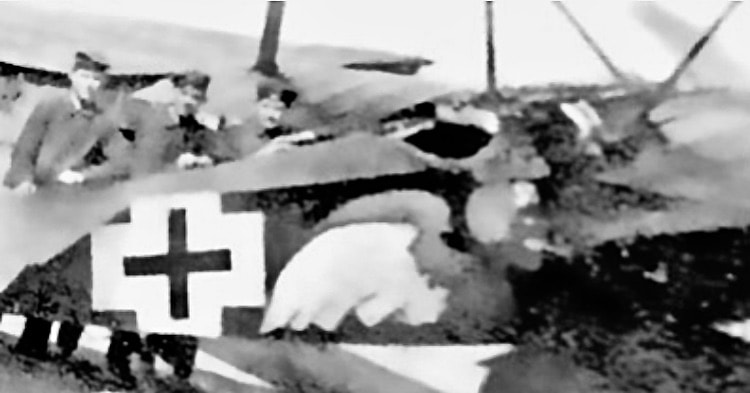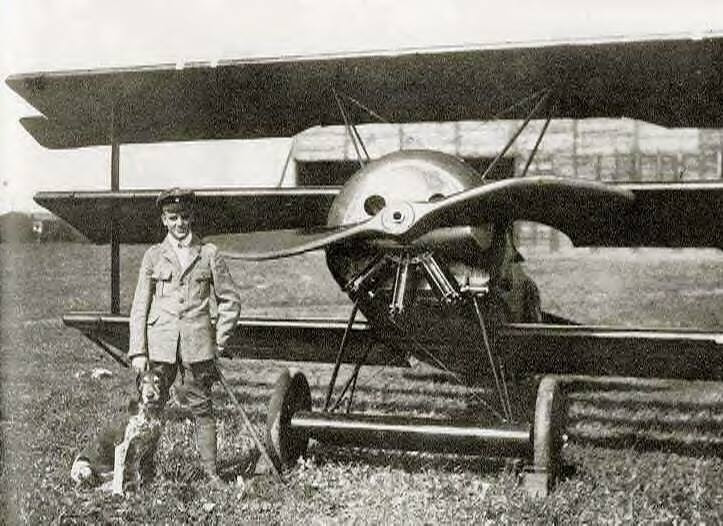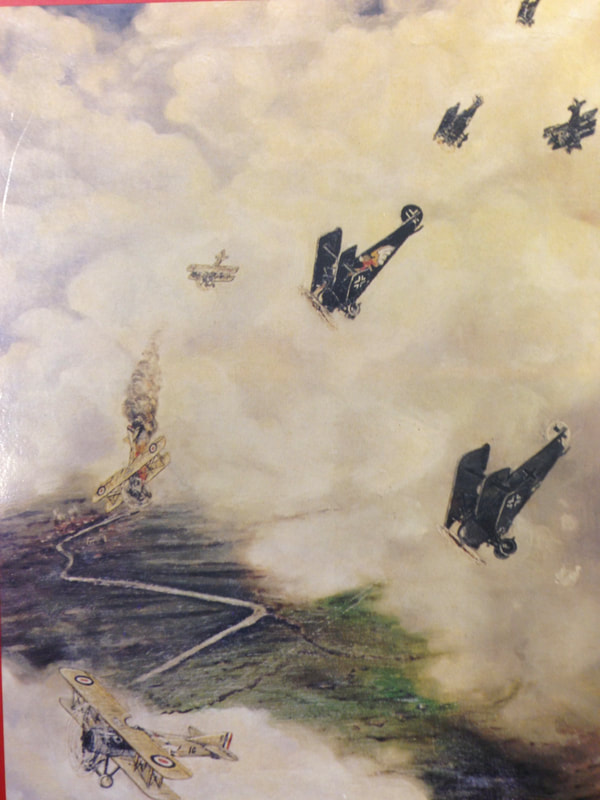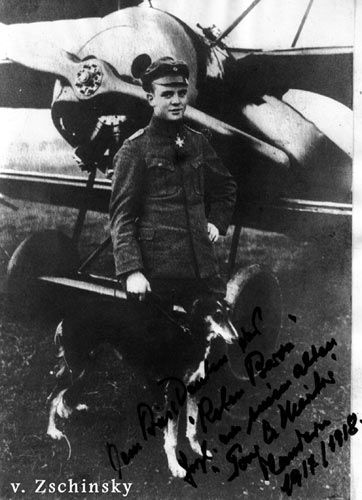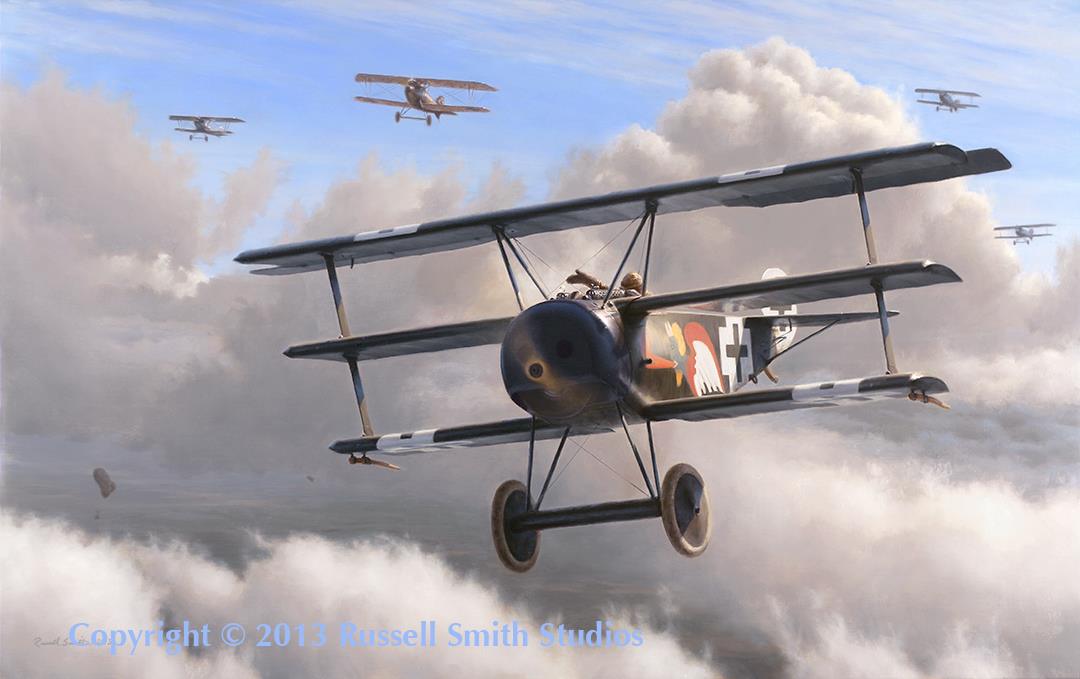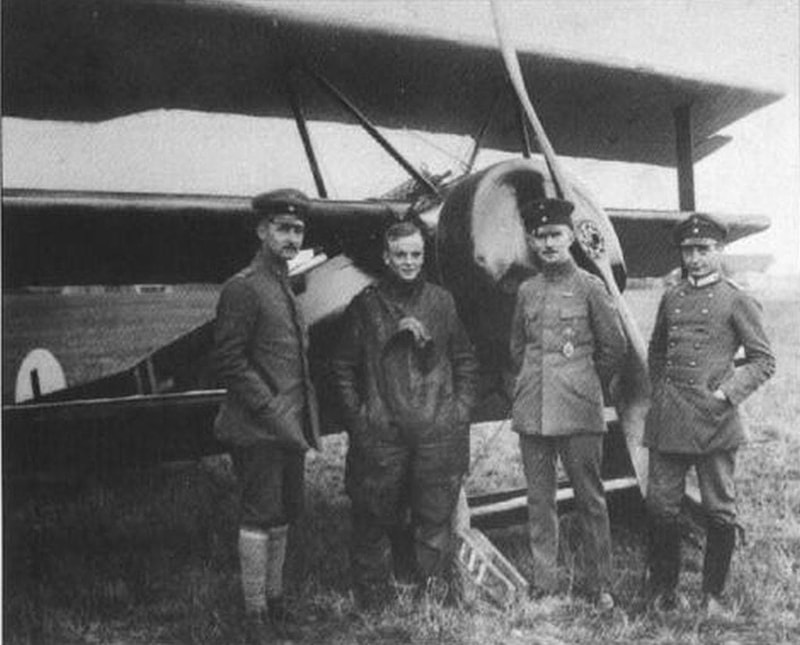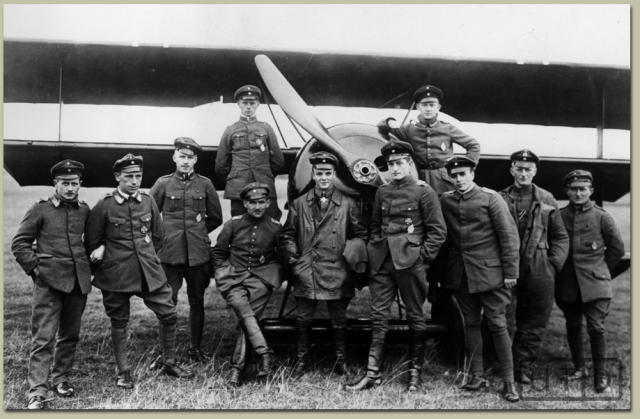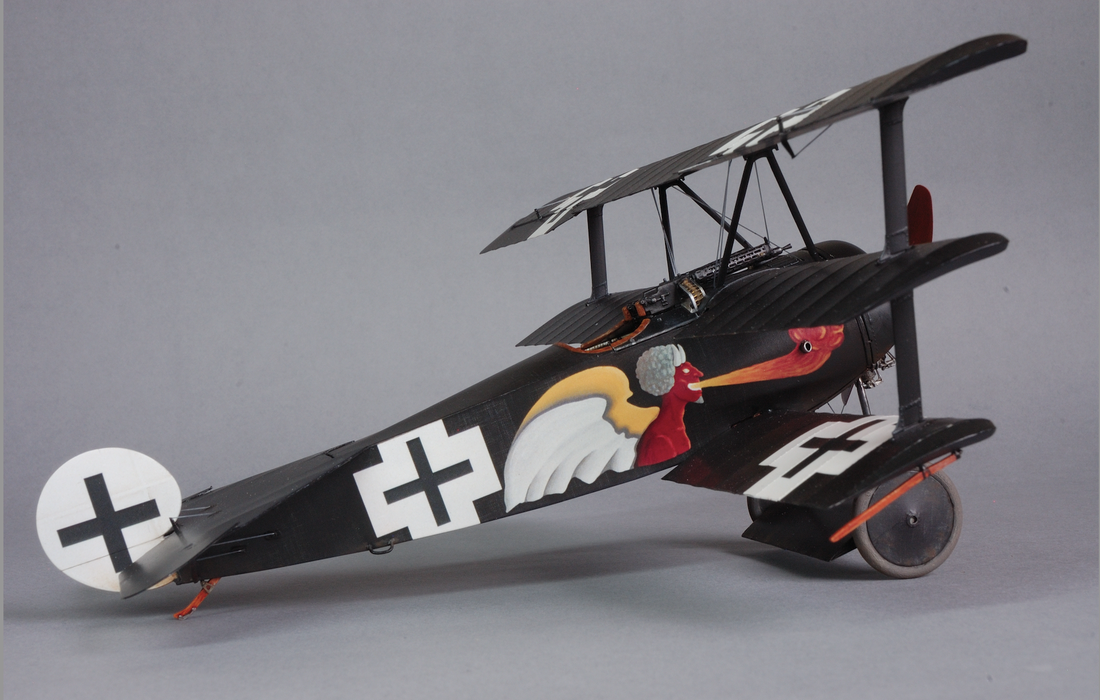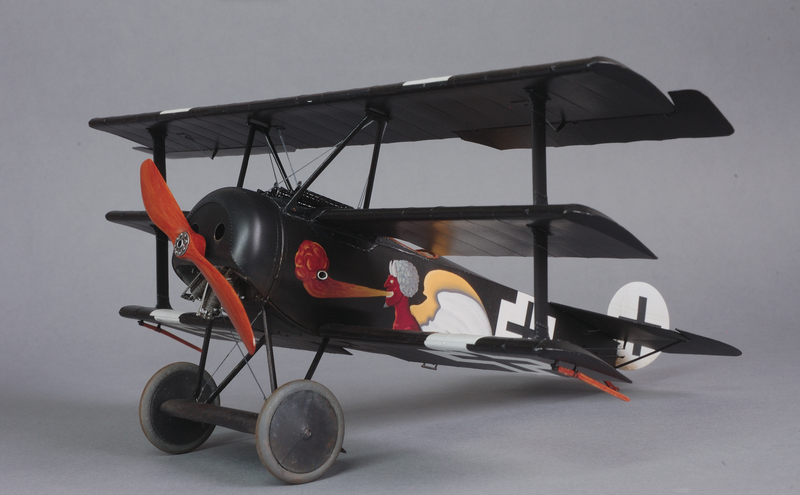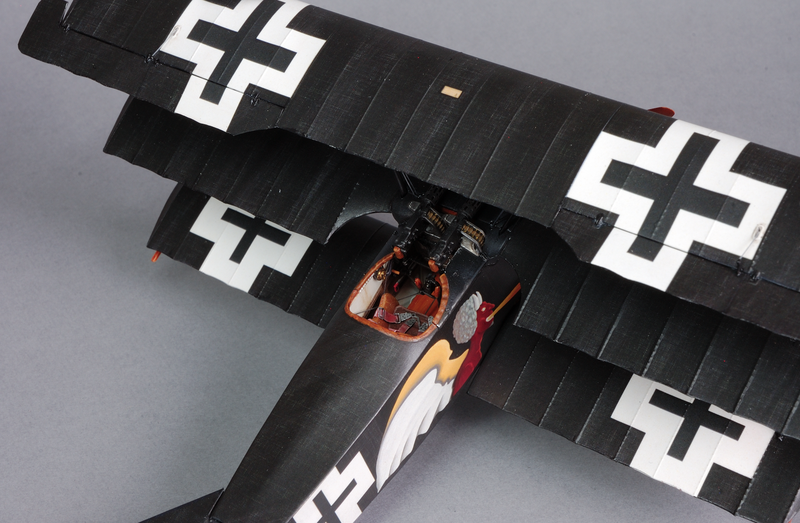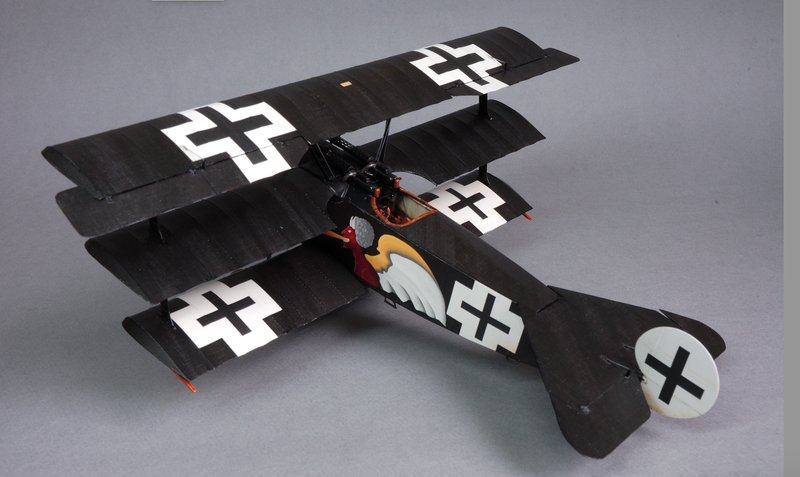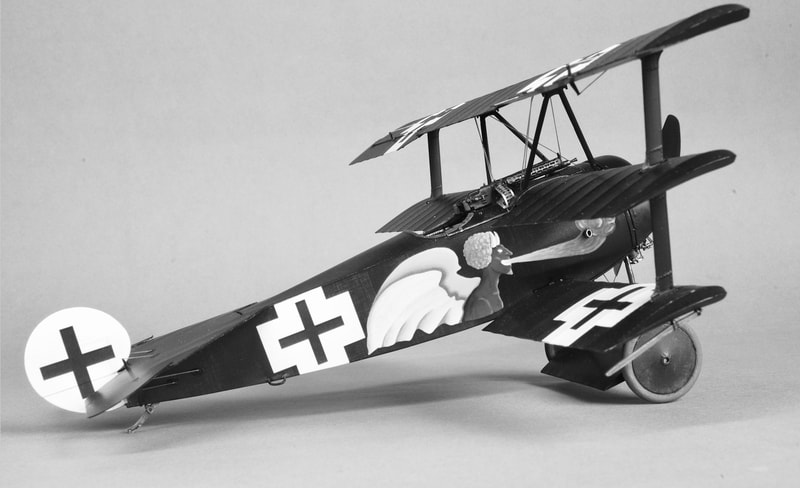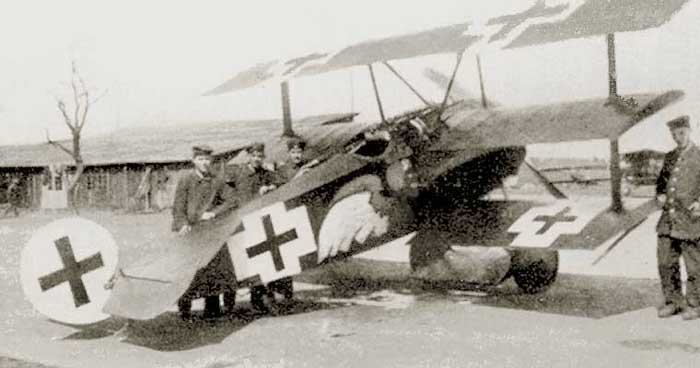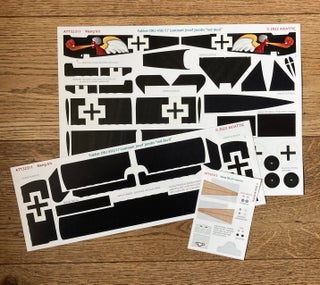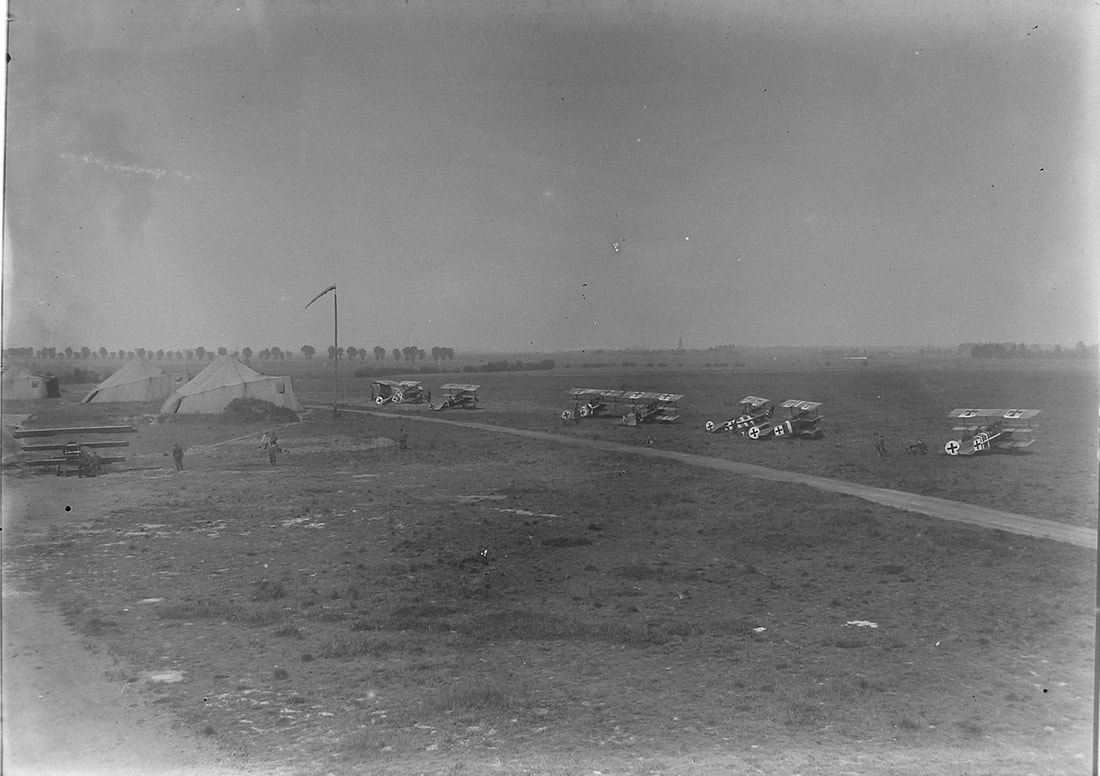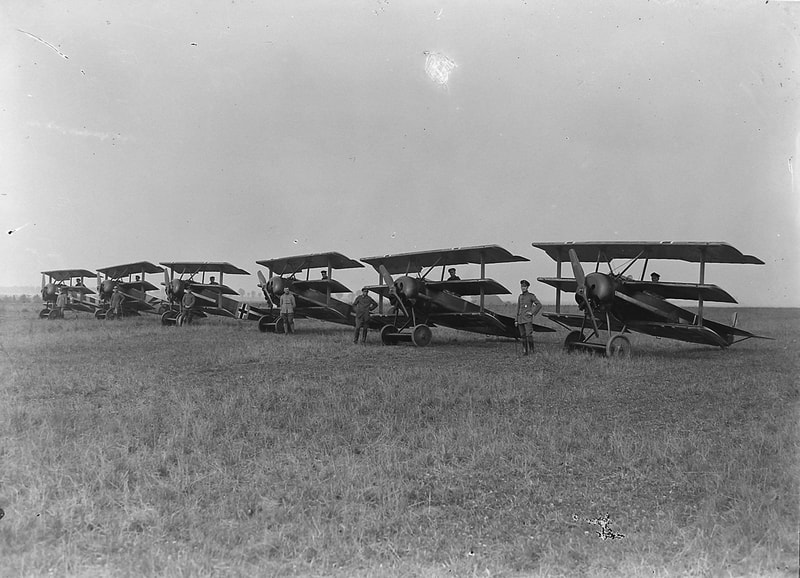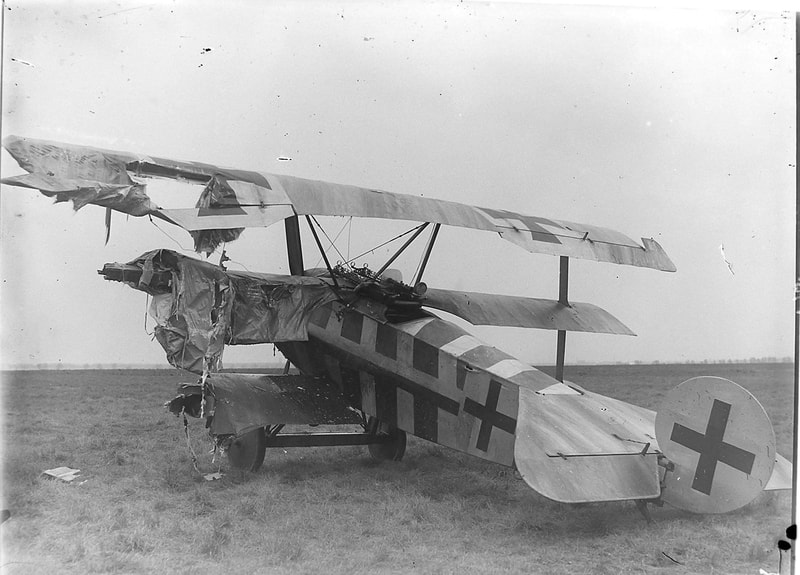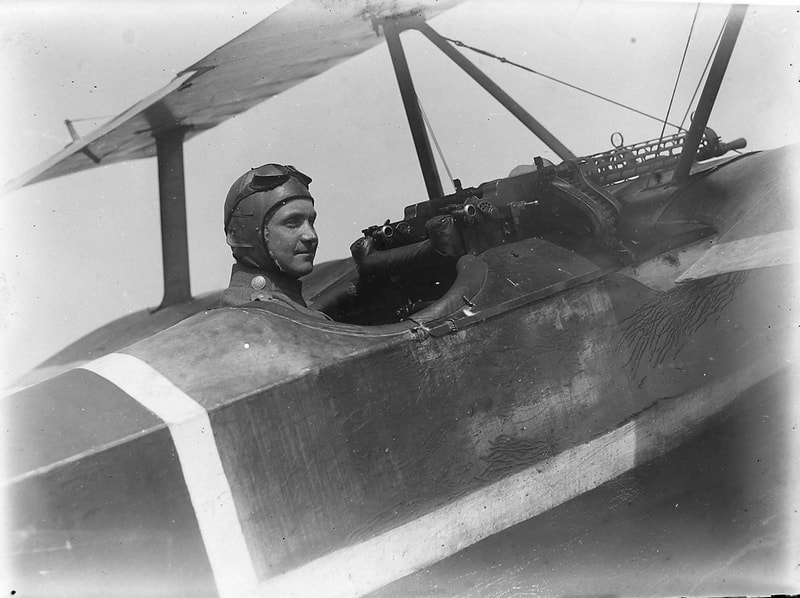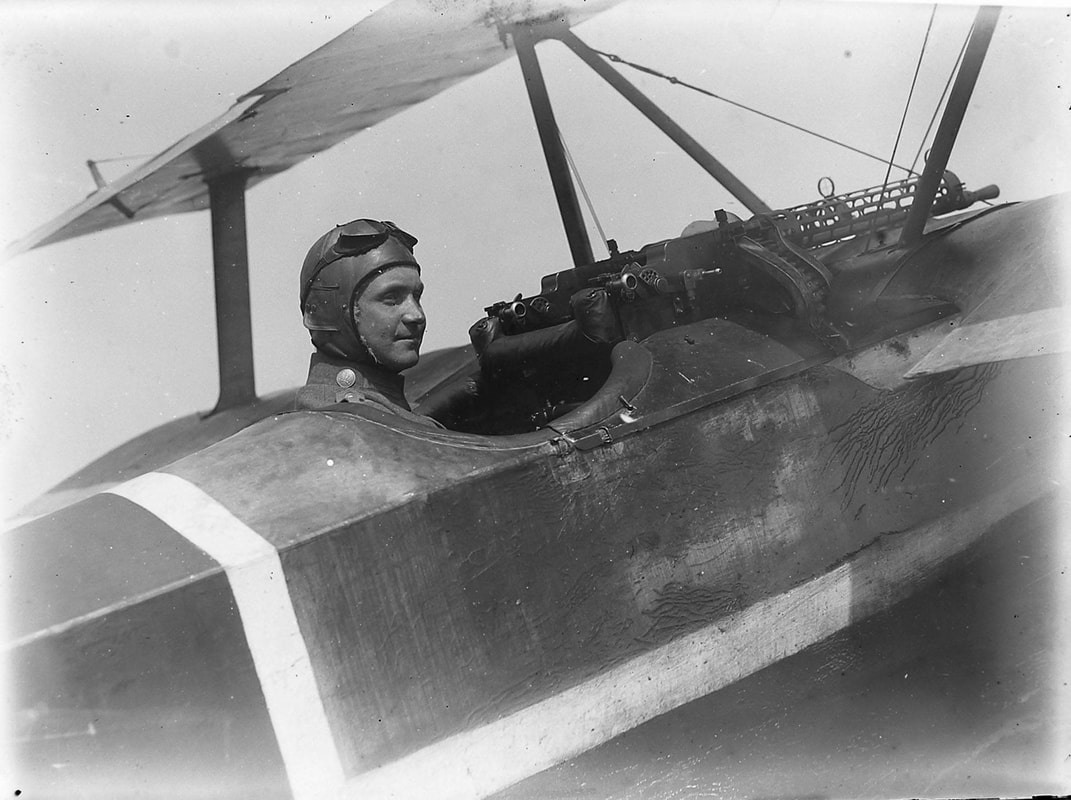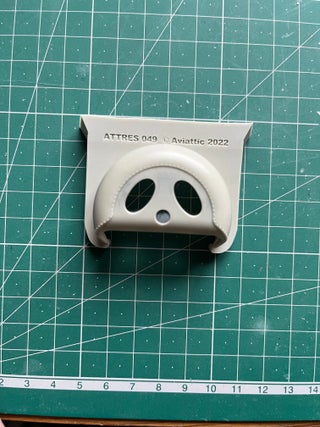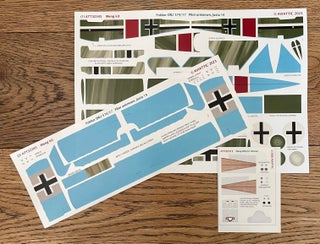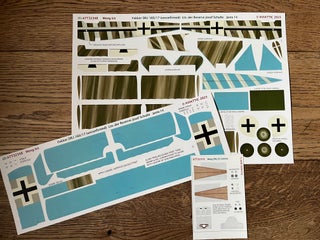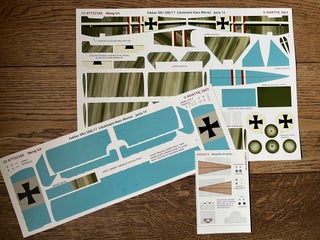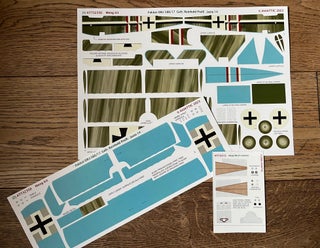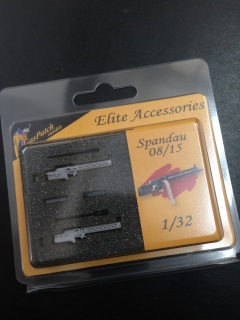The Meng/Wingnut Wings circus
is landing!...
re-designed for the Meng/WNW Fokker DR.I and F.I!
Designed by Juanita Franzi and myself with colour guidance from Alan Toelle.
All sets include upper, lower surface and interior decals as well as cowling data plate and two "Axial" propeller logos
(the data plate and logos drawn by Rowan Broadbent).
Subtle weave and in some cases, weathering effects, enhance the illusion of a fabric covered model aeroplane.
Match whichever brand of paint you prefer for the metal areas, struts and undercarriage to the applied, finished decal colours.
Olive green?..
Each manufacturer of German aircraft had their own take on camouflage colours, usually but not always complying with Idflieg guidelines.
Fokker green, I believe, was a medium bright green, its hue only altered by the varnish as it aged.
Capture and combat reports on Fokker triplanes describe the finish as "green", "olive green" and "brown" and this is explained by the ageing of the linseed element of the dope used, once exposed to the elements for a period of time. Several surviving linen examples we have studied (and some you'll see on the internet) have changed colour to a tobacco brown/yellow glazed effect in the subsequent 100 years, which cannot be assumed to have been achieved during the aircraft's relatively short service life.
Generic sets and some choice future schemes will feature different effects.
These decals represent the fresh appearance of this streaked paint effect and you should match your metalwork colour, with a scale satin/gloss effect, to the medium green (or individual pilot's colour) on the sheet.
New, shiny dope, varnish and paint soon matted once exposed to the elements.
No two triplanes finish was identical (despite what has recently been said) and you can apply your own random streaking, in matched green or aged shades thereof, to copy photographs of a particular machines streaking "footprint".
New theories - and remember, that's all they are - suggest that a mix of brown and green was applied. Ray Rimell's forthcoming triplane build specials promise some new ideas on Fokker camouflage colours..
The nature of colour shifts in paint pigments and varnishes with time is not well understood it seems but if you wish to add some olive/ brown bands of colour this can easily be done on top of your base undercoat before or after applying the decals, which are translucent.
Two Meng beauties from Mark Krumrey - with Aviattic streaked decals..
ATT32313 (for Meng kit) Fokker F.I/Dr.I interior linen, plywood, seat and instrument faces
This set is included in the triplane decal sets but, due to popular demand, it is also offered as a "stand alone" set for those wishing to paint their own exterior finishes.
PLEASE NOTE :
THIS SET DOES NOT NOW CONTAIN THE DATA PLATE AND AXIAL LOGO DECALS. THESE CAN BE FOUND ON THE EXCELLENT VALUE SET ATT32314.
ATT32314 1/32 Fokker F.I/DR.I serial numbers, stencils, weights tables, Voss "face" etc
A6 sheet filled with Fokker font serials, numbers, propellor stamps, Axial transfers, cowling data plates etc., plus correctly proportioned Voss cowling "face" to fit the Meng kit.
Traditionally screen-printed.
Enough (without repetition of too many numbers!) for six builds of Fokker Triplanes!
(Product photo W.I.P - not finished artwork, for copyright reasons...)
A few additional placement possibilities - spotted after the instruction leaflet went to print!..
ATTRES 053 (1/32 for Meng kit) Replacement Fokker F.I/DR.I 3-D printed fuselage panel PLUS etched fret ATTPE014
Special offer bundle for those wishing to portray the fuselage access panel "open".
3d printed panel designed by Mike Swinburne
Etch designed by Richard Andrews and Ron Kootje
NEW! 3d printed control columns for the Meng/Wingnut Wings Fokker triplane kits !
Gerry works in close co-operation with Achim Engels, the German "all things Fokker" expert and replica aircraft builder.
Due to the "unusual" conditions of the Meng triplane releases they were not of the final quality we would have expected, had they been released by Wingnut Wings, and many of the parts in the kits hint at what may have been in store..
The kit-supplied control columns do not reflect the differing styles of the series through "F.I" through "Late" designs.
Serial number groupings are our only real clue as to what may be deemed "Early", "Mid" and "late" but MvR's iconic 425/17 certainly had a field-modified stick which is represented in this exquisite range.
Limited numbers of the 1/32 sticks are in stock..
ATTRES 061 1/32 Fokker Nutz Fokker DR.I control column early production
3d printed
Designed by Gerry Mos
ATTRES 062 1/32 Fokker Nutz Fokker DR.I control column mid production
3d printed
Designed by Gerry Mos
ATTRES 063 1/32 Fokker Nutz Fokker DR.I control column MvR 425/17 field modification
3d printed
Designed by Gerry Mos
ATTRES 064 1/32 Fokker Nutz Fokker DR.I control column late production (also suitable D.VI & EV/D.VIII)
3d printed
Designed by Gerry Mos
ATTRES 066 1/32 Fokker Nutz Fokker F.I control column
3d printed
Designed by Gerry Mos
ATT32292 (Meng kit) Fokker F.I 102/17 Rittmeister Manfred von Richthofen and Ltn. Kurt Wolff
The triplane enjoyed a brief, successful period on the Western Front but eventually it's prowess as a nimble, fast climbing dog-fighter was superseded by it's lack of speed. Shoddy workmanship, which resulted in a series of fatal accidents, meant it was soon recalled and Idflieg-ordered changes were made to construction processes and covering techniques.
As a result it wasn't produced in great quantities and the fuselage serial number ranges were falsely increased to give the impression that many more were in service.
Both Wolff and Voss were killed in these first machines in September 1917.
Match cowling, metal forward fuselage coaming, struts and undercarriage legs to the green on the decal sheet.
These machines were not in service long enough for the poorly-applied fuselage varnish coat to discolour.
ATT32293 (Meng kit) Fokker DR.I 114/17 Rittmeister Manfred von Richthofen
114/17 features overpainted cross fields for the national insignia to conform with Idflieg instructions of a 5cm white border. It appears to have been very well done with even streaking applied to the rudder, fuselage and top wing and matched blue paint on the undersurface of the lower wing in an attempt to match the standard factory-applied camouflage.
The Rittmeister had an accident landing this machine, close inspection of the crash photograph indicates a telegraph cable or similar wrapped around elements of the wing was to blame.
Cowling may have been painted the standard Jasta 11 red.
ATT32294 (Meng kit) Fokker DR.I 152/17 Rittmeister Manfred von Richthofen
Flown whilst achieving victories 64 to 66 this triplane had its top wing, tail, all its struts, wheel covers and cowling painted red, as was Jasta 11 practice at this time. The turtledeck painted red right up to the cockpit coaming to render the effect of a red-painted aircraft complete when seen from above.
ATT32295 (Meng kit) Fokker DR.I 525/17 Rittmeister Manfred von Richthofen (Jasta 6 machine)
Thought to have been flown during a visit to Jasta 6 on 17th March 1918.
This aircraft had coloured strips at the leading edge tips of each wing.
Their purpose is unknown and the colours could be interpreted as black, red, even yellow, I have given black with red as an option. If choosing red you will need to remove the black parts of the decals before application.
ATT32296 (Meng kit) Fokker DR.I 161/17 Rittmeister Manfred von Richthofen
Flown by the Rittmeister on another visit to Jasta 5 at Boistrancourt airfield on 21st March 1918 - exactly one month before his death.
ATT32297 (Meng kit) Fokker Dr.I 477/17 Rittmeister Manfred von Richthofen
477/17, werk nummer 2013, flown late March, early April 1918 by MvR.
Circular carburettor inspection hatches fitted at some point, "in the field".
ATT32298 (Meng kit) Fokker Dr.I 127/17 Rittmeister Manfred von Richthofen (1st version)
127/17, werk nummer 1838, flown late March 1918 by MvR.
ATT32299 (Meng kit) Fokker Dr.I 127/17 Rittmeister Manfred von Richthofen (2nd version)
127/17, werk nummer 1838, flown late March 1918 by MvR.
Red recognition paint applied.
ATT32300 (Meng kit) Fokker Dr.I 425/17 Manfred von Richthofen (1st version)
425/17, werk nummer 2009, flown late March, early April 1918 by MvR.
ATT32301 (Meng kit) Fokker Dr.I 425/17 Manfred von Richthofen (last version)
425/17, werk nummer 2009, flown April 1918 by MvR.
Lothar's crash in this aircraft is unusually well documented with photographs but, irritatingly, most are slightly out of focus, crucial details hidden and the grey-scale interpretation of colour cannot be judged simply as many still think.
I have assumed that this aircraft is indeed 454/17 but, like his brother, Lothar could well have had more than one aircraft at his disposal at this time.
The over-painting of the top wing surface in yellow paint, though an attractive option, is just not confirmed by the photos which clearly show the green over-paint on insignia fields but the exposed aileron is still in it's standard, streaked finish.
I would be nice to imagine that Jasta 11 had all it's aircraft decorated in true, cohesive "circus" style with the top wings of the triplanes of Weiss, Karjus, et al all gaily painted in recognition colours but this didn't happen.
Add to this the conflicting information the photographs give us of the rest of the airframe that can be caused by light refraction and surface finish, differing effects across the surfaces of both fabric and enamel-painted areas and you have a real head-scratcher!
After much consideration I am offering three possible (admittedly in my order of preference) options - each of which has it's merits - none of which can be judged as "wrong"...though, no doubt, someone will!
Match your choice of paint to the decal wheel cover red colour for gloss/eggshell red cowling, undercarriage legs and struts.
Medium green paint for the forward fuselage metal cowling, matched roughly to the darkest green of the streaking decal.
Neither colour needs to be a perfect match as the straight enamel (metal parts) and its thinned version (streaking paint) would not appear quite the same.
ATT32303 (Meng kit) Fokker F.I 103/17 Ltn. Werner Voss (unbleached linen)
The triplane enjoyed a brief, successful period on the Western Front but eventually it's prowess as a nimble, fast climbing dog-fighter was superseded by it's lack of speed. Shoddy workmanship, which resulted in a series of fatal accidents, meant it was soon recalled and Idflieg-ordered changes were made to construction processes and covering techniques.
As a result it wasn't produced in great quantities and the fuselage serial number ranges were falsely increased to give the impression that many more were in service.
Both Wolff and Voss were killed in these first machines in September 1917.
I believe the prototypes had all linen covered areas painted pale blue,
however this set omits that from the upper surfaces, should you believe otherwise.
Match cowling, metal forward fuselage coaming, struts and undercarriage legs to the green on the decal sheet.
As chrome yellow was the adopted Jasta 10 recognition colour, Voss' machine may have had a replacement cowling painted this colour at some time in its very active but brief existence.
It is possible that 103/17 was fitted with a standard green cowling at the time of Voss' final battle as no mention was made on any combat report, despite each pilot having clear sight of it for several minutes, of a painted "face" or yellow..
NOW INCLUDED : screen-printed Voss 'face' cowl decal
ATT32304 (Meng kit) Fokker F.I 103/17 Ltn. Werner Voss (blue painted linen)
The triplane enjoyed a brief, successful period on the Western Front but eventually it's prowess as a nimble, fast climbing dog-fighter was superseded by it's lack of speed. Shoddy workmanship, which resulted in a series of fatal accidents, meant it was soon recalled and Idflieg-ordered changes were made to construction processes and covering techniques.
As a result it wasn't produced in great quantities and the fuselage serial number ranges were falsely increased to give the impression that many more were in service.
Both Wolff and Voss were killed in these first machines in September 1917.
I believe the prototypes had all linen covered areas painted pale blue before having the mid-green streaked camouflage applied. This set reflects that.
Match cowling, metal forward fuselage coaming, struts and undercarriage legs to the green on the decal sheet.
As chrome yellow was the adopted Jasta 10 recognition colour, Voss' machine may have had a replacement cowling painted this colour at some time in its very active but brief existence.
It is possible that 103/17 was fitted with a standard green cowling at the time of Voss' final battle as no mention was made on any combat report, despite each pilot having clear sight of it for several minutes, of a painted "face" or yellow..
NOW INCLUDED : screen-printed Voss 'face' cowl decal
ATT32305 (Meng kit) Fokker Dr.I streaked camouflage, pale blue painted linen undersurfaces
Generic streaking on upper surfaces and blue under on clear backing.
4 x sheet set includes undersurface painted blue linen and interior decals with instrument faces, including tiny sheet of screen printed Axial logos and cowling Fokker data plate!
Apply your choice of linen colour as gloss primer for the streaking decals.
Undersurface of this "clear" set will require either linen colour of your choice and/or white painted fields before you decal.
ATT32306 (Meng kit) Fokker Dr.I streaked camouflage on unbleached linen, pale blue painted linen undersurfaces
Generic streaking on upper surfaces over unbleached linen effect and blue undersurface with unbleached linen national insignia fields.
4 x sheet set includes undersurface painted blue linen and interior decals with instrument faces, including tiny screen printed sheet with Axial logos and cowling Fokker data plate!
ATT32307 (Meng kit) Fokker Dr.I streaked camouflage "aged varnish" , pale blue linen under surfaces
Generic "aged varnish" streaking on upper surfaces and blue under on clear backing for you to undercoat with desired linen colour of your choice..
4 x sheet set includes undersurface painted blue linen and interior decals with instrument faces, including tiny sheet of screen printed Axial logos and cowling Fokker data plate!
Apply your choice of linen colour as gloss primer for the streaking decals.
Undersurface of this "clear" set will require either linen colour of your choice and/or white painted fields before you decal.
ATT32308 (Meng kit) Fokker Dr.I streaked camouflage on unbleached linen "aged varnish", pale blue linen under surfaces
Generic "aged varnish" streaking on unbleached linen upper surfaces and blue under on clear backing.
4 x sheet set includes undersurface painted blue linen and interior decals with instrument faces, including tiny sheet of screen printed Axial logos and cowling Fokker data plate!
It is believed that many but not all Dr.I underside national marking fields were left in their natural, unbleached linen state and varnished. This is simulated on this set.
ATT32311 (for Meng kit) Fokker DR.I 450/17 Leutnant Josef Jacobs "Red Devil"
This iconic scheme has been unimaginatively rendered thus far but now I offer a much more "painterly" interpretation of this fire-breathing devil!
Painted by a young art student on the ground crew staff of Jasta 7 I do not believe he would have produced a crude cartoon (as usually portrayed) and so, after much careful study of the one available blurry photograph and the "dogfight" painting that Jacobs himself confirmed as the correct colouring, my art student son, Will and I have added the kind of detail that was present in so many better-documented schemes. Jacob's was reportedly delighted by this surprise from his staffer-mates! Switching our rendition to monotone and comparing to the photograph was a startling revelation!...
Jasta 14 line-up!
ATTRES 048 (Meng kit) 1/32 Fokker DR.I cowling enlarged cooling holes
Several Jasta 14 DR.I's survived into the hot Summer of 1918 and as result had their cooling holes enlarged in-the-field to prevent the engine over-heating. Jasta Boelcke also adopted this practice.
A different shape of cutout - and a side shape - are inscribed on the inside of your cowling. These shapes can be realised by careful filing.
Cowling design by Mike Swinburne.
OUT OF STOCK - PRE-ORDER NOW FOR JANUARY 2024 DISPATCH
ATT32345 (Meng kit) Fokker DR.I 574/17 Pilot unknown, Jasta 14
Late production DR.I with smaller axle wing. The unusually proportioned national marking alterations show that not all ground crew fully understood the confusing directives from Idflieg when re-painting!
ATT32348 (Meng kit) Fokker DR.I 160/17 (unconfirmed) Ltn. Der Reserve Josef Schulte, Jasta 14
Ltn. der Reserve Schulte had two Dr.I's similarly painted with a wound stripe over the units vertical black and white vertical fuselage band. He crashed both and no known photographs can confirm their serial numbers.
As with many Jasta 14 triplanes, ground crew do not appear to have been in a hurry to alter the wing crosses to the straight-armed 'Balkenkreuz' style which were altered on the (easier to reach!) fuselage and rudder.
This early machine appears to have had the cowling cooling holes enlarged.
See resin cast item ATTRES 048
ATT32349 (Meng kit) Fokker DR.I 588/17 Ltn. Hans Werner, Jasta 14
The second of two similarly painted DR.I's of Ltn. Werner. whilst under his ownership it retained the original 'Eisernes Kreuz' (Iron Cross) national markings and he had added red to the vertical fuselage bands.
Confusion over serial numbers in British capture reports has meant that positive identification is difficult - 583/17 is another possibility.
This machine was passed on to new pilot Ltn. Reinhold Preiß, who was brought down eleven days later on the 9th August 1918. By then it had the fuselage and rudder national insignia updated in line with Idflieg orders.
ATT32350 (Meng kit) Fokker DR.I 588/17 (unconfirmed) Lin Reinhold Preiß, Jasta 14
This machine was passed on to new pilot Ltn. Reinhold Preiß, who was brought down eleven days later on the 9th August 1918. he was captured alive and made a P.O.W.
By then it had the fuselage and rudder national insignia updated in line with Idflieg orders but not the wings. Ground crew had more pressing concerns in the Summer of 1918..
This late production machine appears to have had the cowling cooling holes enlarged.
See resin cast item ATTRES 048.
Gaspatch 1/32 Spandau 08/15 (Mid period) machine guns (Pair)
Exquisite 3D printed Spandaus (pair) from Costas and the team at Gaspatch Models
